new posts in all blogs
Viewing: Blog Posts Tagged with: Obituaries, Most Recent at Top [Help]
Results 51 - 75 of 312
How to use this Page
You are viewing the most recent posts tagged with the words: Obituaries in the JacketFlap blog reader. What is a tag? Think of a tag as a keyword or category label. Tags can both help you find posts on JacketFlap.com as well as provide an easy way for you to "remember" and classify posts for later recall. Try adding a tag yourself by clicking "Add a tag" below a post's header. Scroll down through the list of Recent Posts in the left column and click on a post title that sounds interesting. You can view all posts from a specific blog by clicking the Blog name in the right column, or you can click a 'More Posts from this Blog' link in any individual post.
Here’s the second part of my interview with Steve Moore, with more to follow. The first part can be found here, along with some explanation of how the interview came about.
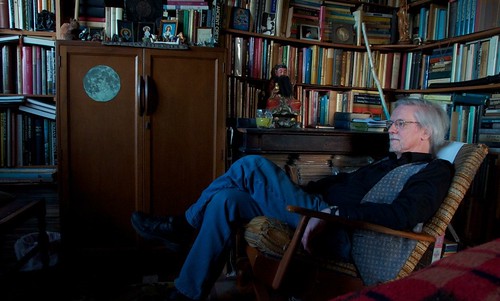
PÓM: Did you go to many SF cons?
SM: Only two or three, I think … at least, that’s all I remember! They were all in the mid-60s, and after that I started losing interest in SF in favour of comics. And by the end of the decade I’d pretty much lost interest in conventions in general.
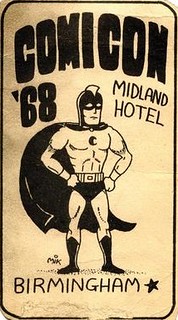 PÓM: You were involved in the first British comics conventions as well, I believe?
PÓM: You were involved in the first British comics conventions as well, I believe?
SM: The first two, yes. The first one was at the Midland Hotel in Birmingham in August 1968, and the organising committee was Phil Clarke, his then girlfriend Kay Hawkins and myself. Being on the spot in Birmingham, Phil and Kay did most of the actual organising, while I helped out with publicity (mainly through Odhams’ Power Comics line) and printing with my ‘trusty’ Roneo. I’d already printed off a couple of personal sales-lists for Phil called The Comic Fan, which we then turned into two issues of The Comic Fan Special, which was our news-bulletin, and also listed comics (mainly Phil’s) that were being sold to raise money for expenses. Looking at the second issue of this, I see there was going to be a convention booklet, which I wasn’t going to be printing, but if I still have a copy of that, it must be somewhere in the loft.
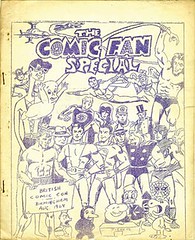 I remember very little about that first convention (for many years I thought it had been in 1967!), though I recall the hotel as being big, old and gloomy. I think there may have been about 50 or 60 people there, and a few ‘non-attending’ members. There was the usual stuff: movies, panel discussions, auctions, but I only know this from looking at the bulletin, not from memory! It was all very small scale, and modelled on what we knew of SF conventions, but we had a good time and that was how it all started. I’m afraid I’m one of the guilty men …
I remember very little about that first convention (for many years I thought it had been in 1967!), though I recall the hotel as being big, old and gloomy. I think there may have been about 50 or 60 people there, and a few ‘non-attending’ members. There was the usual stuff: movies, panel discussions, auctions, but I only know this from looking at the bulletin, not from memory! It was all very small scale, and modelled on what we knew of SF conventions, but we had a good time and that was how it all started. I’m afraid I’m one of the guilty men …
Anyway, I obviously hadn’t had enough, as I got involved with the second one as well, at the Waverley Hotel in London, the following year. This time the committee was Frank Dobson, Derek Stokes, Alan Willis (of whom I remember nothing whatever), and myself. It was bigger, more organised … and again I remember virtually nothing about it, though this time that was mainly because I was in a blind, exhausted panic through most of the weekend, trying to make sure that everything worked. And that was enough organising for me. I went to the third in Sheffield, and I think to another one at the Waverley. And then I’d really had enough of conventions in general, and entered my ‘reclusive phase’ … which has lasted for about 40 years so far!
->PÓM: You have been a recluse, apparently, ever since then. Did you just decide it all wasn’t for you, or what happened?
SM: I’m basically a recluse as far as comic conventions and personal appearances go, that’s all. I have a number of very close friends, some going back decades, who I like to see as often as possible, and I’m certainly not agoraphobic in terms of not wanting to leave the house! But by the time we got to the comic cons I was working in the business, which made me a bit of a ‘celebrity’, and I’ve never had any interest in that. And the idea of being in a large room full of people who know me, when I don’t know them, just makes me uncomfortable. Besides, by 1972 I’d gone freelance, and I made a conscious decision to stop reading other people’s comics so I could develop my own style, so what was the point of going to a convention to discuss things I was no longer familiar with or interested in? By then I just wasn’t ‘a comic fan’ any more. So I just withdrew from that whole scene.
PÓM: Do you remember who attended those early comic cons?
SM: Well, looking at the membership list published in an issue of The Comic Fan Special, I see that a number of notable fans were due to be at the first one, like Dave McCullough, Nick Landau, Pete Phillips and Paul Neary. But if you’re asking me who I remember, apart from Phil, Kay and myself, it basically comes down to Jim Baikie, who was living not far from me in South Norwood at the time, and with whom I developed a fairly close friendship, before he moved back to the Orkneys.
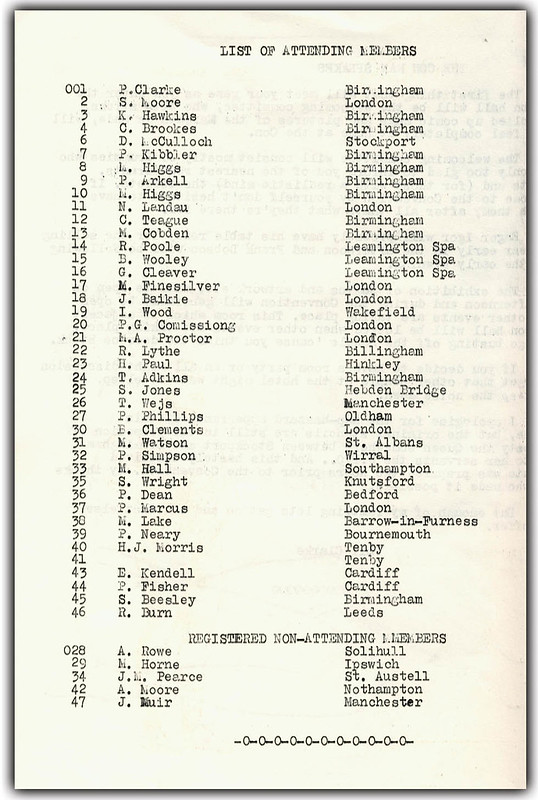
The membership list for the first Comicon
As for the second one, like I said, it was pretty much of a blur. But among those there were Alan Moore, Steve Parkhouse, Barry Smith and Bob Rickard, the future founder of Fortean Times, none of whom I had as much time to talk to as I would have liked. I also remember shouting at a young kid called Dave Womack, who was making a rather loud nuisance of himself throughout the weekend, and being baffled by an Edgar Rice Burroughs fan called Frank Westwood, who asked me where he could find a Roman Catholic church on the Sunday morning; something which had simply never occurred to me to find out (and which, at the time, I actually thought was pretty weird; after all, when there was a comic book convention going on, why would you want to go to church?).
PÓM: What do you think drove you to want to produce all those fanzines?
SM: Essentially, it was what fans did in those days. There was no internet, no blogs, so if you wanted to do stuff about comics, you did fanzines. It was a mushroom industry in the late 60s, early 70s, especially as cheap offset printing started to come in. Everybody seemed to be doing it … some people were doing four or five at once, on different topics, and the adzines were both offering comics for sale, but advertising all the various fanzines as well. And fanzine editors would trade both copies and adverts with one another, as well as offering space for articles, etc., that you might not have wanted to do in your own fanzine. In many ways it was a bit like an early version of the internet, but done with printed paper, envelopes and postage stamps. It’s how we kept in touch.
 As I’ve said, I was mainly interested in getting new material together, rather than articles, and I don’t think I wrote much about comics, preferring to contribute stuff to magazines that fringed away from comics into fantasy and underground material, like John Muir’s Crucified Toad. A strange man who, I’m told, ended up in some sort of shady business in the East, and got himself murdered for it. Or so I’m told.<-
As I’ve said, I was mainly interested in getting new material together, rather than articles, and I don’t think I wrote much about comics, preferring to contribute stuff to magazines that fringed away from comics into fantasy and underground material, like John Muir’s Crucified Toad. A strange man who, I’m told, ended up in some sort of shady business in the East, and got himself murdered for it. Or so I’m told.<-
PÓM: Wasn’t it around that time that you first started working in comics yourself?
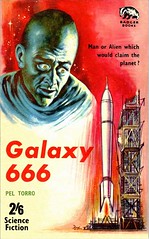 SM: That’s right. If we backtrack to autumn 1966, I’d been stuck in the laboratory job for a year. So I decided to write letters to half a dozen comics publishers in London (yes, there were actually that many comics publishers in those days) and simply asked them if they had any jobs. I got polite replies (‘no’) from a couple of them, and one offer of an interview, from John Spencer & Co., the publishers of Badger Books, who at the time were publishing a couple of really bad black-and-white superhero books, which in the end only lasted a couple of issues each. So I made my way over to West London one evening to their tiny premises, which I think was pretty much one office and a storeroom, but it turned out they basically wanted a warehouseman, which really wasn’t what I was looking for. So I knuckled down to the flour samples and sulphuric acid fumes again.
SM: That’s right. If we backtrack to autumn 1966, I’d been stuck in the laboratory job for a year. So I decided to write letters to half a dozen comics publishers in London (yes, there were actually that many comics publishers in those days) and simply asked them if they had any jobs. I got polite replies (‘no’) from a couple of them, and one offer of an interview, from John Spencer & Co., the publishers of Badger Books, who at the time were publishing a couple of really bad black-and-white superhero books, which in the end only lasted a couple of issues each. So I made my way over to West London one evening to their tiny premises, which I think was pretty much one office and a storeroom, but it turned out they basically wanted a warehouseman, which really wasn’t what I was looking for. So I knuckled down to the flour samples and sulphuric acid fumes again.
And then six months later, out of the blue, I got a letter from a lady at Odhams Press, saying they had a vacancy for an office junior. At the time, they were publishing their ‘Power Comics’ line, which revolved round reprinting Marvel strips in black-and-white, which was right up my street. I went for an interview and was told I was a bit too old, being nearly 18, but I was enthusiastic, knowledgeable about American comics, and I could show them Ka-Pow. So they offered me the job. Everyone at Rank’s told me I was making a really bad mistake, giving up a job with ‘prospects’ to be an office boy, and for less money too … but I was off as soon as my week’s notice had run out.
I started at Odhams, in their offices at 64 Long Acre, on 1st May 1967. The date sticks in my mind because the first thing they did was send me over to Blackfriars to join the NATSOPA trade union and, of course, being Mayday, the offices were shut. Perhaps not the best of omens to start my career with …
Having arrived, I found that I was actually the junior office junior, there being another guy who’d already been there a year or two. My duties were pretty much getting post in and out of the building, running errands, and so on, but I adopted a simple strategy: when I didn’t actually have any specific tasks, I’d head for the offices of the various different comics and asked the editors if there was anything they needed me to do for them. So within three months I’d leapfrogged the other guy (who I don’t think ever did get beyond being office junior) and got myself promoted to junior sub-editor on Pow! and Fantastic. Both of these were run from the same office, under the editorship of long-time professional scriptwriter Ken Mennell who, I see from looking on the web, sadly seems to be far more honoured in France than in the land of his birth … probably as a result there being no credits for writers and artists in those days. We were a team of four: Ken, who was also contracted to write a couple of adventure scripts a week as part of his duties, a senior sub-editor called Jane, another sub-editor called Paul, and myself. And I was working in professional comics …
PÓM: What did all those sub-editors actually do, or was that just a catch-all title for anyone who worked on a given title?
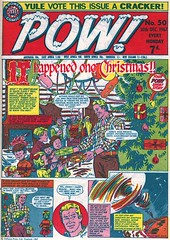 SM: Well, we were producing two titles a week, Pow! and Fantastic, so everything was on a pretty tight schedule. Ken Mennell was in overall charge and made the ‘strategic’ decisions, like which strips we’d run, in collaboration with managing editor Alf Wallace. I think Jane was mainly responsible for Fantastic, which, being mostly page-for-page reprints of Marvel Comics in black-and-white, with only one original strip (‘The Missing Link’, which later evolved into ‘Johnny Future’; written by Alf Wallace and drawn by Luis Bermejo), was a relatively simple, one-person job. Paul and I worked on Pow! which was a bit more complicated, being more a of traditional British comic apart from the ‘Spider-man’ reprint, which had to be resized to fit a British page format. It was mostly one or two page humour strips, with one or two original adventure strips, so that meant a lot to keep track of. We had a large-format ‘make-up book’, with two pages per issue and a sort of grid system on them, in which we’d write the dates that scripts arrived; when they were sent to the artist; when the artwork came back; when the pages were sent to the letterer (all hand-lettering in those days; no computer setting) and when they came back; and so on. Scripts had to be read and edited before they were sent out, and when the finished, lettered pages were in they had to be proofread and sent to the art department (the ‘bodgers’) for correction. I think we all proofread the pages to make sure nothing got through that shouldn’t be there, as the letterers were known to be occasionally mischievous … particularly John Aldrich, who seemed to take every possible opportunity to letter ‘public’ as ‘pubic’, and so on, just to see what he could get through … and Ken, as editor, certainly checked all the pages after we juniors had been through them. It was also drummed into us that we should never allow the use of the word ‘flick’ or the name ‘Clint’, which, when lettered in capitals were dangerously liable to turn into something quite unsuitable for a kid’s comic. Another maxim I learned very early on was ‘all printers are bloody idiots’, which meant their instructions had to be spelled out absolutely precisely, especially when it came to things like marking up the artwork with its reproduction size. Again, all this was pre-computers, so we were sending original artwork to the printer, and all the corrections had to be done by hand, rather than on screen. Obviously we also got proofs back from the printers that had to be checked through as well. ‘Editorial’ largely consists of reading stuff over and over again.
SM: Well, we were producing two titles a week, Pow! and Fantastic, so everything was on a pretty tight schedule. Ken Mennell was in overall charge and made the ‘strategic’ decisions, like which strips we’d run, in collaboration with managing editor Alf Wallace. I think Jane was mainly responsible for Fantastic, which, being mostly page-for-page reprints of Marvel Comics in black-and-white, with only one original strip (‘The Missing Link’, which later evolved into ‘Johnny Future’; written by Alf Wallace and drawn by Luis Bermejo), was a relatively simple, one-person job. Paul and I worked on Pow! which was a bit more complicated, being more a of traditional British comic apart from the ‘Spider-man’ reprint, which had to be resized to fit a British page format. It was mostly one or two page humour strips, with one or two original adventure strips, so that meant a lot to keep track of. We had a large-format ‘make-up book’, with two pages per issue and a sort of grid system on them, in which we’d write the dates that scripts arrived; when they were sent to the artist; when the artwork came back; when the pages were sent to the letterer (all hand-lettering in those days; no computer setting) and when they came back; and so on. Scripts had to be read and edited before they were sent out, and when the finished, lettered pages were in they had to be proofread and sent to the art department (the ‘bodgers’) for correction. I think we all proofread the pages to make sure nothing got through that shouldn’t be there, as the letterers were known to be occasionally mischievous … particularly John Aldrich, who seemed to take every possible opportunity to letter ‘public’ as ‘pubic’, and so on, just to see what he could get through … and Ken, as editor, certainly checked all the pages after we juniors had been through them. It was also drummed into us that we should never allow the use of the word ‘flick’ or the name ‘Clint’, which, when lettered in capitals were dangerously liable to turn into something quite unsuitable for a kid’s comic. Another maxim I learned very early on was ‘all printers are bloody idiots’, which meant their instructions had to be spelled out absolutely precisely, especially when it came to things like marking up the artwork with its reproduction size. Again, all this was pre-computers, so we were sending original artwork to the printer, and all the corrections had to be done by hand, rather than on screen. Obviously we also got proofs back from the printers that had to be checked through as well. ‘Editorial’ largely consists of reading stuff over and over again.
So, all that had to be controlled, and artists and writers phoned up and chased to make sure everything was on schedule. Then there was the mail to go through (perhaps a hundred letters and postcards a week, most of which was unusable) and pick out possible items for the letters page, and we’d ask the kids who wrote in to include a coupon on which they named their three favourite strips; so these had to be added up to give us an idea what was most popular. And at the same time we were working on a new project, a much more traditional adventure comic in the Lion mould called Spitfire, which had no Marvel reprints; but that never got beyond the dummy stage, as by then the Power Comics line was starting to contract. So we had plenty to keep us occupied, though we always left the office on time; I don’t remember us ever being pressurised into actually doing any overtime.
That was also when I got my first freelance work, though it wasn’t writing. As the Spider-man material we were reprinting in black-and-white was merely the line-work for something had originally been drawn for colour, we used to give it a bit more body by applying Zipatone (an adhesive film that had to be imported from the States at the time, which was then laid on the artwork and cut to shape with a scalpel) to various parts of the pictures. I managed to persuade the art editor, John Jackson, that I could do that, and did so for a number of months. It paid a massive 5/- a page, but to put that in perspective, my weekly salary was only something like £15.
PÓM: What was the Power Comics line, which you mentioned above?
 SM: Basically it was Odhams’ attempt to model itself on Marvel Comics and included a fair amount of Marvel reprint. The titles involved were Wham! and Smash! , which were already established as more traditional British comics, but then started to include one or two Marvel reprints, with the American material
SM: Basically it was Odhams’ attempt to model itself on Marvel Comics and included a fair amount of Marvel reprint. The titles involved were Wham! and Smash! , which were already established as more traditional British comics, but then started to include one or two Marvel reprints, with the American material
resized to fit a British page;
Pow! which was in the same format, but was first published at the beginning of the Power Comics line, and
Fantastic and
Terrific, which were in a more American format, each page reproducing a single American page, though each carried one original, British-created strip. There were letters pages, and all the comics carried a half-page news section, in imitation of Marvel’s ‘
Bullpen Bulletins’, ‘
From the Floor of 64’, which was named after 64 Long Acre, the office address; while instead of ‘Smilin’ Stan’ Lee, we had ‘Alf, Bart and Cos’: Alf Wallace, the managing editor, Robert Bartholomew, his No. 2 and editor of
Eagle, and Albert Cosser, editor of
Smash! and
Terrific (who later went on to edit
TV Times for several years). I’m not sure why Ken Mennell wasn’t included in that lot, but maybe they couldn’t fit him in with the ‘A, B, C’ of the other three.
As I said, the offices were at 64 Long Acre, an old newspaper building on the edge of Covent Garden. The ground floor was full of loading bays and was still in use for storing enormous rolls of newsprint, etc. We occupied the entire first floor, which was divided up into smaller offices with metal and frosted glass partition walls. The place was actually a listed building, but it stood on a very prime piece of real estate. A few months after we moved out of the building, it burned to the ground, thus allowing a large and costly redevelopment to take place. Curious, that …
PÓM: What other comics were Odhams producing at the time?
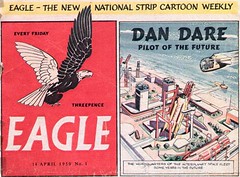 SM: Eagle and Robin, which Odhams had taken over from their original publisher, Hulton Press, in 1959. Their companion papers, Swift and Girl had already folded by then. Eventually all the Power Comics titles started to suffer from declining sales, and merged with each other until there was only Smash! left. Then in 1969 Odhams and Fleetway were merged to become IPC Magazines, and that was pretty much the end of the line. For the last few months of Odhams’ independent existence we moved from Long Acre to offices in High Holborn, and then with the merger everything was transferred to Fleetway House in Farringdon Street.
SM: Eagle and Robin, which Odhams had taken over from their original publisher, Hulton Press, in 1959. Their companion papers, Swift and Girl had already folded by then. Eventually all the Power Comics titles started to suffer from declining sales, and merged with each other until there was only Smash! left. Then in 1969 Odhams and Fleetway were merged to become IPC Magazines, and that was pretty much the end of the line. For the last few months of Odhams’ independent existence we moved from Long Acre to offices in High Holborn, and then with the merger everything was transferred to Fleetway House in Farringdon Street.
PÓM: What was the British comics industry like at the time?
SM: It was in pretty good health, which was probably about the last time you could say that. There were Odhams and Fleetway in London, and D. C. Thomson in Dundee, all with a sizeable number of titles, and a few smaller publishers. Of course, Odhams (and IPC after 1969) was the only one I had direct experience of, and that was also the first one that really had any awareness that there might actually be ‘fans’ to be catered to, rather than just kids who bought the comics off the newsstands. But all the creators were anonymous, this being long before anyone got credits, so there was far less egotism than there is in present-day comics. I tend to look back on it as ‘days of honest toil’, when you had a bunch of solid, professional writers and artists who’d turn in their material on time and take their pay-cheques without ever thinking they were doing anything particularly interesting, because they were working for children’s magazines, and that was how they made their living. I think I was pretty much the first fan to get into the business, and after that there were a few others, but in 1967 things were pretty much a closed shop, often with people introducing friends or members of their own family to the editorial staff. Ken Mennell’s son Ian ended up on editorial at IPC, while the writer Ted Cowan’s son Geoff was on the editorial staff of Eagle. At the time no one thought there was anything ‘special’ about comics, and I think a number of the editorial staff just considered it a relatively easy way to get their press cards from the National Union of Journalists, which they could then use as a stepping stone to move on to a better job as a magazine journalist.
PÓM: Did you sell any of your stories at that time?
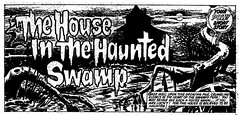 SM: The first story I sold professionally was a three-page ‘Pow Short Story’ called ‘The House in the Haunted Swamp’, that appeared in Pow! No. 45, late in 1967. It was drawn by a Turkish artist living in this country, called Ayhan Basuglu, and taught me a swift lesson, similar to the one about all printers being idiots … which was that you had to write for artists as if they were idiots as well, especially if English wasn’t their first language. It was set in a decaying house full of barrels of paraffin, and I’d told the artist to draw a guy exploring the place with a torch in his hand … meaning, of course, an electric flashlight. Mr. Basuglu promptly drew him with flaming torch, which wasn’t quite what I’d intended with all that paraffin around, so I had to do a bit of rewriting on the dialogue. By one of those weird symmetries, the same sort of thing happened on the last comic strip I wrote as well, Hercules: The Knives of Kush. On one issue they brought in a couple of Mexican artists to fill in, as Cris Bolson was getting behind schedule. My script asked for some characters wearing skullcaps, by which I meant close-fitting felt caps covering the cranium, and they drew a bunch of guys with actual skulls on their heads. Fortunately we managed to catch that at the pencil stage, so it wasn’t a problem, but with 40 years between the two events, you understand my feeling of déjà vu …
SM: The first story I sold professionally was a three-page ‘Pow Short Story’ called ‘The House in the Haunted Swamp’, that appeared in Pow! No. 45, late in 1967. It was drawn by a Turkish artist living in this country, called Ayhan Basuglu, and taught me a swift lesson, similar to the one about all printers being idiots … which was that you had to write for artists as if they were idiots as well, especially if English wasn’t their first language. It was set in a decaying house full of barrels of paraffin, and I’d told the artist to draw a guy exploring the place with a torch in his hand … meaning, of course, an electric flashlight. Mr. Basuglu promptly drew him with flaming torch, which wasn’t quite what I’d intended with all that paraffin around, so I had to do a bit of rewriting on the dialogue. By one of those weird symmetries, the same sort of thing happened on the last comic strip I wrote as well, Hercules: The Knives of Kush. On one issue they brought in a couple of Mexican artists to fill in, as Cris Bolson was getting behind schedule. My script asked for some characters wearing skullcaps, by which I meant close-fitting felt caps covering the cranium, and they drew a bunch of guys with actual skulls on their heads. Fortunately we managed to catch that at the pencil stage, so it wasn’t a problem, but with 40 years between the two events, you understand my feeling of déjà vu …
I know I wrote another ‘Pow Short Story’ called ‘The Hunter out of Time’, which, like the first one, suffered from the usual beginner’s error of having far too many words per panel, and there may have been one or two more. Those are the only two I know I wrote, because in those early days I’d keep a scrapbook of the stories I’d done, but after I’d been freelance a few months there got to be so many of them I just gave up. When I was on editorial for Whizzer & Chips at IPC I wrote a four-episode fill-in on ‘Wonder-Car’, which I really enjoyed as it was drawn by Ron Turner, someone I’d long admired. But I didn’t really write a great deal while I was working in-house, and when I went freelance in 1972, it was pretty much a leap in the dark. I thought I could write, but I didn’t actually have any sort of track record that said I could. It was pretty much the way I blundered through my career. ‘You want a prose story written (or a novel, or a movie script, or whatever)? Oh yeah, I can do that …’ I never had any prior experience of doing them, but as it turned out, I could. Looking back, I seem to have got away with an awful lot, somehow. It’s just that I’m not sure how I did it!
PÓM: Do you remember many of the people who worked on the comics?
SM: As for the in-house staff, apart from the people I’ve already mentioned I mostly just remember first names, though the overall art editor was John Jackson, his assistant Roger Barnden. One of the senior sub-editors on Eagle was a guy called Dan Lloyd, who also happened to be the assistant editor on Flying Saucer Review, and when I was still the office boy I’d sometimes have to run UFO stuff between him and the editor, Charles Bowen, who worked at South Africa House in Trafalgar Square. At one point Dan had his new toy set up in the Eagle office, which was next door to ours … a ‘flying saucer detector’, which I think was some sort of magnetometer that FSR was promoting, so Roger Barnden used to sneak into our office and slap a powerful magnet on the metal partition wall, just to wind up Dan by setting off his detector.
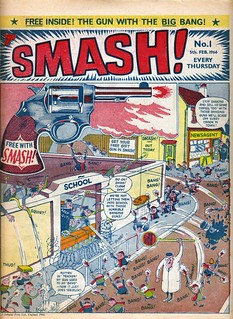 As for creators, a lot of the humour strips were written by Walter Thorburn, who we’d lured away from D. C. Thomson, who were notorious for paying less than their London-based competitors. They’d also lured away Leo Baxendale, though I think he worked mainly for Wham! As for the adventure strips, I think Ken Mennell wrote mainly for Smash! … I’m fairly sure he wrote ‘Rubber Man’ ‘Bunsen’s Burner’ and ‘Cursitor Doom’ for them. Another string to his bow was coming up with plot outlines for thriller novels for the publisher W. Howard Baker, who had a stable of writers who’d then write them up. Ken would knock out the outlines in his lunch hours, at £30 a time, and I was obviously impressed by his productivity. Other adventure writers were Tom Tully and Scott Goodall, but I can’t remember which strips they were responsible for. As for humour artists, there was Mike Brown, who was very much a Leo Baxendale clone, and who I suspect may well be the artist on some material that’s been mistakenly identified as Baxendale. There was Mike Higgs, writing and drawing ‘The Cloak’, and the brilliant Ken Reid on ‘Dare-a-Day Davy’, who was actually a bit of a nightmare to work with, as he’d rewrite all the scripts he was sent, and we’d get back this lovely artwork with tiny pencilled dialogue in the balloons that was twice as long as would actually fit if lettered properly, so we had to cut it in half to make it work. There was Graham Allen and Terry Bave, who also wrote his own stuff. As for adventure artists, there were John Stokes and Eric Bradbury, though a fair number of stories were by Spanish artists, working through agencies like the Temple Art Agency.
As for creators, a lot of the humour strips were written by Walter Thorburn, who we’d lured away from D. C. Thomson, who were notorious for paying less than their London-based competitors. They’d also lured away Leo Baxendale, though I think he worked mainly for Wham! As for the adventure strips, I think Ken Mennell wrote mainly for Smash! … I’m fairly sure he wrote ‘Rubber Man’ ‘Bunsen’s Burner’ and ‘Cursitor Doom’ for them. Another string to his bow was coming up with plot outlines for thriller novels for the publisher W. Howard Baker, who had a stable of writers who’d then write them up. Ken would knock out the outlines in his lunch hours, at £30 a time, and I was obviously impressed by his productivity. Other adventure writers were Tom Tully and Scott Goodall, but I can’t remember which strips they were responsible for. As for humour artists, there was Mike Brown, who was very much a Leo Baxendale clone, and who I suspect may well be the artist on some material that’s been mistakenly identified as Baxendale. There was Mike Higgs, writing and drawing ‘The Cloak’, and the brilliant Ken Reid on ‘Dare-a-Day Davy’, who was actually a bit of a nightmare to work with, as he’d rewrite all the scripts he was sent, and we’d get back this lovely artwork with tiny pencilled dialogue in the balloons that was twice as long as would actually fit if lettered properly, so we had to cut it in half to make it work. There was Graham Allen and Terry Bave, who also wrote his own stuff. As for adventure artists, there were John Stokes and Eric Bradbury, though a fair number of stories were by Spanish artists, working through agencies like the Temple Art Agency.
It was while working on Pow! and Fantastic in 1967 that I first met Steve Parkhouse and Barry Smith (this was before he moved to the States and started calling himself Barry Windsor-Smith). They turned up one day as a writer-artist team, trying to sell us an SF strip as a ‘Pow Short Story’. It wasn’t accepted, but Barry ended up drawing the pin-ups of Marvel characters on the back cover of Fantastic and Terrific. I’m not exactly sure when he started, but the early pin-ups were drawn in-house by John Jackson.
PÓM: Did you end up working with any of your professional colleagues on any of your fan publications?
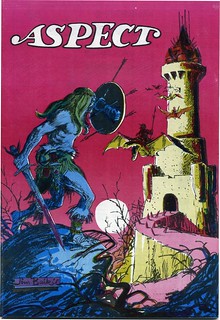 SM: Eventually, yes. I’d started another fanzine called Aspect, the first issue of which appeared in September 1969. It was the first comics fanzine I’d done using a Gestetner duplicator, and was run off for me by Derek Stokes, but I wasn’t at all pleased with it; in fact I was rather embarrassed at the way it came out. But by the time I got round to doing the second issue, in March 1970, I’d got in touch with the guys at Orion Press in Manchester, who were essentially fan printers, but who could do justified typesetting and litho printing, including fairly primitive overlay colour covers. Steve and Barry had been working on a large Kirby-esque epic called ‘Paradox Man’ which I was quite eager to run, but instead Barry decided to intercut pages from that with a number of apparently unrelated other pages and the whole thing ended up as a sort of 20-page montage called ‘Tales of Hyperborea’, which looked very nice, so long as you didn’t expect any sort of connected narrative. There was a prose sword-and-sorcery by Chris Lowder, who I was by now working with at IPC, and who later started calling himself Jack Adrian, with a career as a writer, anthologist and critic; that was illustrated by Steve Parkhouse. And there was an article on Frankenstein movies by Denis Gifford.
SM: Eventually, yes. I’d started another fanzine called Aspect, the first issue of which appeared in September 1969. It was the first comics fanzine I’d done using a Gestetner duplicator, and was run off for me by Derek Stokes, but I wasn’t at all pleased with it; in fact I was rather embarrassed at the way it came out. But by the time I got round to doing the second issue, in March 1970, I’d got in touch with the guys at Orion Press in Manchester, who were essentially fan printers, but who could do justified typesetting and litho printing, including fairly primitive overlay colour covers. Steve and Barry had been working on a large Kirby-esque epic called ‘Paradox Man’ which I was quite eager to run, but instead Barry decided to intercut pages from that with a number of apparently unrelated other pages and the whole thing ended up as a sort of 20-page montage called ‘Tales of Hyperborea’, which looked very nice, so long as you didn’t expect any sort of connected narrative. There was a prose sword-and-sorcery by Chris Lowder, who I was by now working with at IPC, and who later started calling himself Jack Adrian, with a career as a writer, anthologist and critic; that was illustrated by Steve Parkhouse. And there was an article on Frankenstein movies by Denis Gifford.
For some time, Steve and Barry had been intending to do a magazine called Orpheus, along with Bob Rickard, who they’d actually got in touch with after seeing a letter that Bob had had published in a Marvel Comic. So at that point we decided to merge and brought out the first issue of Orpheus in March 1971, nominally edited by Steve and myself, though we all had an input into the issue. By that time Steve was working at IPC with me on Whizzer and Chips and Cor!! So we roped in a few of our friends from there as well, like Chris Lowder and Robert Knight, and again we had strips by Steve and Barry. We actually managed to get a second issue together and printed by Spring 1973, which featured some very early art by Ian Gibson, but Steve and Barry then decided they weren’t satisfied with it, so it was never released, though I managed to nab one copy for my own files.
Eventually Barry moved to the States and Steve to Carlisle, and, sadly, we lost touch. But Bob’s remained one of my very dearest friends for the last 45 years and, of course, it’s because of that that I’ve had a long-running association with Fortean Times since it began in 1973.
PÓM: Were they good times or bad times at Odhams, do you think, looking back?
SM: Certainly good when I was working on Pow! Ken Mennell was a nice man, London was a hip place to work in 1967 and I was doing what I wanted to do, which was working in comics. As things started to shrink Ken left and I ended up working on Smash! , which wasn’t quite so much fun, simply because I didn’t take to Albert Cosser (who was always called ‘Cos’ rather than Albert) quite as much as I did to Ken, though we got on well enough. By 1969 the writing was on the wall, and we knew about the upcoming merger with Fleetway, and for the last few months we moved from Long Acre to offices in High Holborn. For the last month of its life I worked as extra editorial staff on Eagle, which was quite nice, as I’d grown up with the title, but it was pretty much just a case of giving me something to do. Except for a couple of people, virtually everyone at Odhams took redundancy pay, but I’d only been there a couple of years, so that wasn’t worth anything to me and, besides, I wanted to stay in comics. So I hung on and moved over to Fleetway House as part of the new IPC Magazines set-up where, at least to start with, I wasn’t anywhere near as happy.
PÓM: Why not?
SM: Well, I’d basically gone over to Fleetway House as ‘superfluous editorial staff’, and they promptly put me on Valiant, which already had a full staff so I was, basically, superfluous. And while Odhams had been quite relaxed, the whole ethos at Fleetway was much more old-fashioned, with very rigid and strait-laced working practices. The managing editor was a guy called Jack LeGrand, who looked like a rather beaten-up old newspaper hack. He was probably perfectly nice, but I seem to recall there’d be a vague tremor every time he’d walk into an office. The editor of Valiant, Sid Bicknell, was a complete martinet, and I think his chief sub-editor, who was probably only about 30, used to turn up every day in a three-piece suit and a bow-tie. So I got dumped among a staff like that with my lengthening hair and vaguely hippy notions, and we spent six months in mutual loathing.
Valiant was probably the most old-fashioned of the Fleetway boys’ adventure weeklies, and I particularly detested their lead strip, the ‘jolly’ World War II hero Captain Hurricane, which I thought was nauseatingly jingoistic and downright racist (‘Take that, you piano-toothed rice-noshing baboons!’). I seem to remember working for a couple of weeks on Tiger at the end of my stint on Valiant, but then, without asking me what I thought, they suddenly decided to move me on to War Picture Library, which, of course, I hated even more. For those who don’t remember them, these were pocket sized-comics about seven inches by five, with 56 pages plus covers, and usually two or three panels a page.
Working on War Picture Library was even more dire than Valiant. I remember early on having proofread an issue in 25 minutes, and then being told that I couldn’t have read it properly because all the other staff there took 45 minutes. So after that I had to spend 45 minutes on a book regardless of whether it needed it, and some of the stuff was reprint that had already been subbed anyway. I was bored rigid and hated the subject matter, with its constant references to ‘Huns’ and ‘Nips’, and the typical World War II story is something I’ve always refused to write. Mind you, I’ve never written sport either, but that’s mainly because of ignorance rather than any moral scruples.
PÓM: Did you end up working at IPC Magazines for long?
 SM: Fortunately, after two months of misery on the War libraries, they decided to bring out a new humour weekly called Whizzer and Chips, under a relatively young editor called Bob Paynter; the idea being that Chips was somehow a ‘separate’ comic that was bound inside Whizzer. As was usually the way, they advertised the job of sub-editor in-house first, and I naturally applied for it, and got it. So that’s where I spent the next two years, until I finally left to go freelance in the summer of 1972. During that time, we also added Cor!! to our line-up, which was another humour title. Both were pretty much modelled on Buster, but perhaps with a slightly younger appeal. They were virtually all humour (a lot of which was written by Roger Cook, who’d formally written TV Comic just about single-handedly every week) with, I think, one adventure strip.
SM: Fortunately, after two months of misery on the War libraries, they decided to bring out a new humour weekly called Whizzer and Chips, under a relatively young editor called Bob Paynter; the idea being that Chips was somehow a ‘separate’ comic that was bound inside Whizzer. As was usually the way, they advertised the job of sub-editor in-house first, and I naturally applied for it, and got it. So that’s where I spent the next two years, until I finally left to go freelance in the summer of 1972. During that time, we also added Cor!! to our line-up, which was another humour title. Both were pretty much modelled on Buster, but perhaps with a slightly younger appeal. They were virtually all humour (a lot of which was written by Roger Cook, who’d formally written TV Comic just about single-handedly every week) with, I think, one adventure strip.
We were down on the second floor (most of the comics were on the top floor, which I can’t remember whether it was the 5th or the 6th, with the libraries on the floor below that), so we were pretty much a separate production unit, cut off from the others (which suited me). And in the time I was there, we ended up with Steve Parkhouse and Dez Skinn on editorial (I think Dez was mainly on Cor!! ), and Kevin O’Neill as art assistant. With the usual nepotistic way of taking on staff, we also had an art assistant called Tony Jacob, who was the son of a cartoonist, I think called Peter Jacob, and there was a rather cute artist/letterer called Diane Flowers, who was developing an interest in palmistry and wanted to read my palm (offhand I can’t remember what she said, just the inky palm-prints … though I think it was more about character analysis than prediction). I don’t think Chris Lowder worked with us, but I think he hung around quite a lot, mainly because of the aforesaid palmist. So we had a decent team there, and Steve Parkhouse and I became quite good friends. And I was reasonably happy for a while.
To be continued…
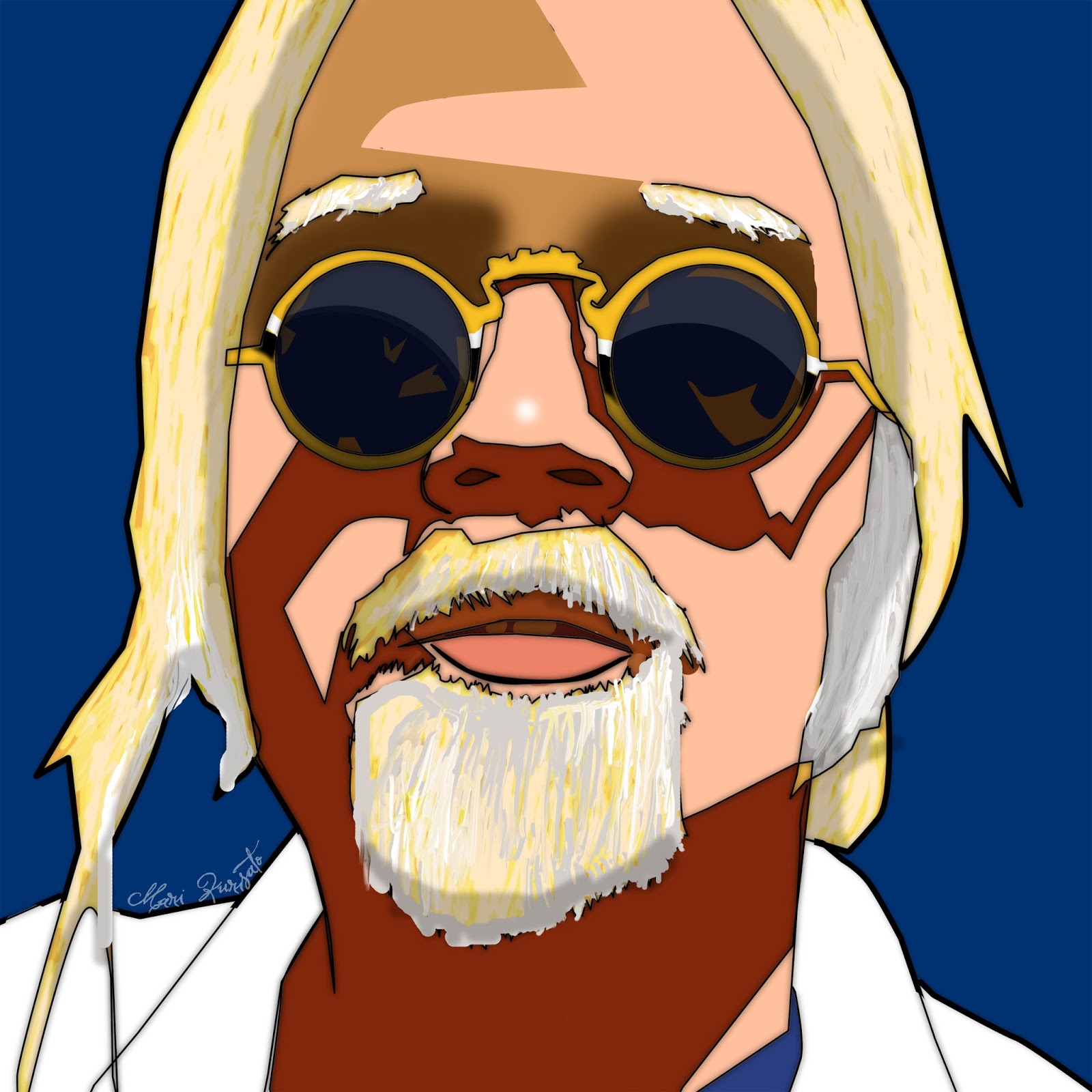 |
| © 2009 Mari Kurisato |
We knew this day was coming, but that doesn't really make it easier.
After years of struggling with cancer,
Jay Lake has died.
Jay leaves a legacy of family, of friendships, of writing, and of science. He had his genome sequenced, and he submitted himself to grueling experimental trials. He could have gone more quietly into this good night; he chose instead to try to help the people of a future that has been denied to him. One of his greatest legacies may be to have helped, in some small or large way, to move us closer to a cure for cancer.
In place of eulogy,
here's something I wrote when Jay could read it.
Farewell, friend.
We were saddened to hear of the passing of Maya Angelou. Here are some books by which to help remember the great author and poet.
 Adoff, Arnold and Andrews, Benny, Editors I Am the Darker Brother: An Anthology of Modern Poems by African Americans
Adoff, Arnold and Andrews, Benny, Editors I Am the Darker Brother: An Anthology of Modern Poems by African Americans
208 pp. Simon 1997. ISBN 0-689-81241-8 PE ISBN 0-689-80869-0
YA (New ed., 1968, Macmillan). Introductory comments by poet Nikki Giovanni and literary critic Rudine Sims Bishop reinforce the continued timeliness of this volume, updated and reissued after nearly thirty years. Expanded with pieces from twenty-one additional poets including Maya Angelou and poet laureate Rita Dove, the collection constitutes a part of the song of America, which, as Bishop states, ‘requires a multi-voiced chorus.’ Ind.
 Angelou, Maya Amazing Peace: A Christmas Poem
Angelou, Maya Amazing Peace: A Christmas Poem
40 pp. Random/Schwartz & Wade 2008. ISBN 978-0-375-84150-7 LE ISBN 978-0-375-94327-0
Gr. K-3 Illustrated by Steve Johnson and Lou Fancher. Angelou’s poem (first read at the 2005 White House tree-lighting ceremony) is about the promise of peace brought on by the Christmas season, urging listeners to “look beyond complexion and see community.” The luminous oil, acrylic, and fabric illustrations on canvas, depicting a snow-covered town, add concreteness to Angelou’s words. A CD of Angelou reading the poem is included.
 Angelou, Maya My Painted House, My Friendly Chicken, and Me
Angelou, Maya My Painted House, My Friendly Chicken, and Me
40 pp. C. Potter 1994. ISBN 0-517-59667-9
Gr. K-3 Photographs by Margaret Courtney-Clarke. Thandi, an eight-year-old Ndebele girl of South Africa, tells about her family, the fine art of house painting carried out mainly by the women in the village, and the contrast between village and city life. Courtney-Clarke’s abundant, brightly colored photographs accompany Angelou’s refreshingly warm introduction to the art, culture, and social life of the Ndebele people.
 Clinton, Catherine, Editor I, Too, Sing America: Three Centuries of African American Poetry
Clinton, Catherine, Editor I, Too, Sing America: Three Centuries of African American Poetry
128 pp. Houghton 1998. ISBN 0-395-89599-5
YA Illustrated by Stephen Alcorn. This chronological collection includes work by such poets as Phillis Wheatley, W. E. B. Du Bois, Arna Bontemps, Maya Angelou, Rita Dove, along with twenty others. The verses, introduced with biographical information, reflect the African-American struggle for equality from the early 1800s to the present. The textured illustrations, done in muted tones, capture the drama and strength of each poem.
 Cox, Vicki Maya Angelou: Poet
Cox, Vicki Maya Angelou: Poet
122 pp. Chelsea 2006. LE ISBN 0-7910-9224-0
YA Black Americans of Achievement, Legacy Edition series. (New ed., 1994.) This biography details Angelou’s rise from adversity to international recognition. The book goes beyond the typical personal information to provide some social history relevant to the subject’s time. Captioned photographs and boxed inserts enhance the conversational text, most of which has been completely revised. Reading list, timeline, websites. Ind.
 Johnson, Claudia, Editor Racism in Maya Angelou’s I Know Why the Caged Bird Sings
Johnson, Claudia, Editor Racism in Maya Angelou’s I Know Why the Caged Bird Sings
150 pp. Greenhaven 2008. LE ISBN 978-0-7377-3901-5
YA Social Issues in Literature series. This volume presents brief, thoughtful essay reprints (primarily written by literary critics and academics) arranged into three sections that explore the author’s life, identify relevant social issues, and discuss current cultural applications. Although the pieces are sometimes awkwardly truncated, they usually present ideas that go well beyond superficial critique, inviting readers to consider fiction as a vehicle for analyzing American identity. Reading list, timeline, Bib., ind.
 Rampersad, Arnold and Blount, Marcellus, Editors African American Poetry: Poetry for Young People
Rampersad, Arnold and Blount, Marcellus, Editors African American Poetry: Poetry for Young People
48 pp. Sterling 2013. ISBN 978-1-4027-1689-8
Gr. 4-6 Illustrated by Karen Barbour. This representative poetry anthology of African American literary masters spans the sixteenth through twentieth centuries and includes renowned poets such as Phillis Wheatley, Lucille Clifton, Maya Angelou, Langston Hughes, and Nikki Giovanni; brief contextual notes accompany each poem. The selections, along with the watercolor, ink, and collage illustrations, reflect not only the black experience but also the evolution of free expression. Ind.
 Wilson, Edwin Graves, Editor Maya Angelou
Wilson, Edwin Graves, Editor Maya Angelou
48 pp. Sterling 2007. ISBN 978-1-4027-2023-9
Gr. 4-6 Illustrated by Jerome Lagarrigue. Poetry for Young People series. After a four-page introduction about Angelou’s life and work, twenty-five of her poems are presented, each with a few explanatory sentences preceding them. Some selections are heavy, resonating with the penetrating philosophical stance from which Angelou views the world; others show a lighter side of the world-renowned wordsmith. Dark abstract paintings create mood and atmosphere. Ind.

The post Books in Remembrance of Maya Angelou (1928-2014) appeared first on The Horn Book.
Famed writer Maya Angelou has passed away. She was 86-years-old.
Here's more from The New York Times: "Throughout her writing, Ms. Angelou explored the concepts of personal identity and resilience through the multifaceted lens of race, sex, family, community and the collective past. As a whole, her work offered a clear-eyed examination of the ways in which the socially marginalizing forces of racism and sexism played out at the level of the individual."
In addition to writing, Angelou proved to be an accomplished Renaissance woman who worked as an activist, entertainer, streetcar conductor, magazine editor, college professor, and lecturer. To commemorate Angelou's life in letters, we have put together a literary mix tape. Below we've included links to free excerpts of Angelou’s books and poems. (Photo Credit: Dwight Carter)
continued...
New Career Opportunities Daily: The best jobs in media.
Via a series of Tweets from
Tamara K. Nopper, I learned that
William Worthy recently died at the age of 92.
I knew very little about Worthy the man, but his name has been one I've known since childhood, because of a
Phil Ochs song about him,
"The Ballad of William Worthy".
My father was a DJ at a radio station in Massachusetts in the 1960s and played that song one day, because though his politics were rather different from those of Ochs or Worthy (he voted for Nixon and generally supported the Vietnam War), he loved to challenge authority and get in trouble. That he did. As he told it, a bunch of little old ladies wrote letters to the station to demand that this upstart DJ be fired. The station manager screamed at him never to play anything like that damned song ever again.
By the time I was old enough to be taught the contents of the record collection at home, I heard that story and listened to the song. It was a catchy tune, and because I associated it with my father's amusing rebellion, I took a particular liking to it and quickly learned the words. And thus I have carried William Worthy's name with me ever since.
William Worthy isn't worthy to enter our door
Went down to Cuba, he's not American anymore
But somehow it is strange to hear the State Department say
You are living in the free world, in the free world you must stay
But Worthy was much more than just a journalist who went to Cuba. His is a story worth learning, a name worth remembering.
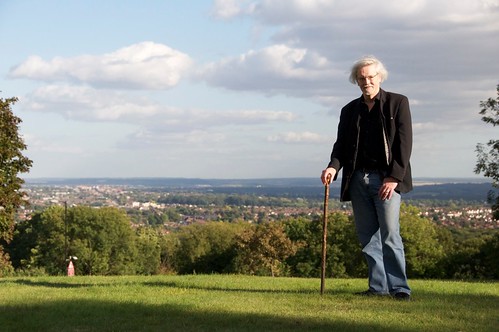 On the 26th of August 2013 I started doing a very long biographical interview with Steve Moore (as mentioned in my earlier post, Steve Moore 1949 – 2014: A Personal Appreciation). The plan was that it would take as long as it would take, and then we’d spend a bit more time fiddling about with it, then decide exactly what we wanted to do with it. Steve died on the 14th of March, give or take a day. At that point, we had reached the end of the questions and answers about his time at Warrior in the early-mid eighties, and I had sent off three final questions about it, just to clarify a few final details, before we moved on to whatever came next. The answers to those questions, although they were written, never got sent, and were found on Steve’s computer after he died. They’ll eventually make their way to me, and will be in the last post in this series.
On the 26th of August 2013 I started doing a very long biographical interview with Steve Moore (as mentioned in my earlier post, Steve Moore 1949 – 2014: A Personal Appreciation). The plan was that it would take as long as it would take, and then we’d spend a bit more time fiddling about with it, then decide exactly what we wanted to do with it. Steve died on the 14th of March, give or take a day. At that point, we had reached the end of the questions and answers about his time at Warrior in the early-mid eighties, and I had sent off three final questions about it, just to clarify a few final details, before we moved on to whatever came next. The answers to those questions, although they were written, never got sent, and were found on Steve’s computer after he died. They’ll eventually make their way to me, and will be in the last post in this series.
In the meantime, there’s 48,000-ish word of interview between us that I have decided needs to be seen, even though it is unfinished. The current plan is to put it up here in reasonably sizeable chunks, every Sunday.
One note on the text: As we went along, I would ask supplementary questions, which got inserted into the previous text. To make it clear where a question has been added in later, I’ve included little arrows for those subsidiary questions, like this: ->. Occasionally, there were further questions, which are indicated by an ever expanding length of arrow, like this –> or this —>. Hopefully this will help to understand how the interview unfolded. So…
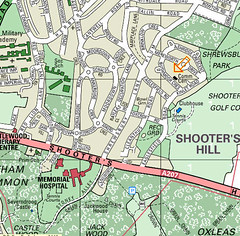 Pádraig Ó Méalóid: Before I get to your own life, can I ask you about your parents? Where they were from, what they did, and how they ended up in the house on Shooters Hill where you were born?
Pádraig Ó Méalóid: Before I get to your own life, can I ask you about your parents? Where they were from, what they did, and how they ended up in the house on Shooters Hill where you were born?
Steve Moore: As far as I can tell, my father, Arthur James Moore, was born in Charlton, South-East London, in 1908, the son of a soldier in the Royal Artillery. For reasons that aren’t very clear (possibly because my grandfather died or left the family), he seems to have started working at the age of 11 for a chemicals company called Frederick Boehm, firstly at Silvertown in East London and later at Belvedere in Kent. He stayed with the same company for the whole of his working life, eventually rising to middle management, before dying of a stroke in 1972.
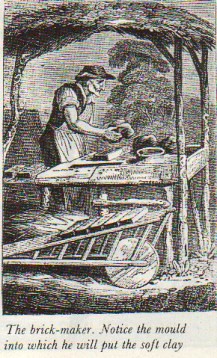 My mother, Winifred Mary Deeks, was born in 1917, and came from New Cross, also in South-East London. I believe she was working as a secretary at Boehm’s when she met my dad, and they married in 1938, after which she became a housewife. She passed away from a stroke in 1985. The Moore side of the family seem to have been pretty much working class: bakers, soldiers and factory workers, and the earliest trace I’ve been able to find is of a Moore who was a farmer in Derbyshire in the 18th century. The Deeks seem to have originated in Suffolk, where my earliest traceable ancestors seem to have been brickmakers. If I have any sort of vague literary connections in my ancestry it seems to be on the Deeks side; grandfather Deeks was a printer, and my Uncle Don was a book distributor who specialised in oriental publications.
My mother, Winifred Mary Deeks, was born in 1917, and came from New Cross, also in South-East London. I believe she was working as a secretary at Boehm’s when she met my dad, and they married in 1938, after which she became a housewife. She passed away from a stroke in 1985. The Moore side of the family seem to have been pretty much working class: bakers, soldiers and factory workers, and the earliest trace I’ve been able to find is of a Moore who was a farmer in Derbyshire in the 18th century. The Deeks seem to have originated in Suffolk, where my earliest traceable ancestors seem to have been brickmakers. If I have any sort of vague literary connections in my ancestry it seems to be on the Deeks side; grandfather Deeks was a printer, and my Uncle Don was a book distributor who specialised in oriental publications.
Jim and Mary, as they preferred to be known, seem to have lived in Charlton to start with, though they eventually bought the house on Shooters Hill in 1942 (Not 1938, as was stated in Alan Moore’s biographical confection about me, Unearthing, though this information only came to light after Alan wrote the piece). By one of those weird twists of fate, when my father was called up in World War II he was disbarred from serving on the front line because he’d worked for Boehm’s, a German-owned company. As a result he ended up in the Home Guard, working on an anti-aircraft rocket battery on Shooters Hill, which at least didn’t give him very far to walk to work.
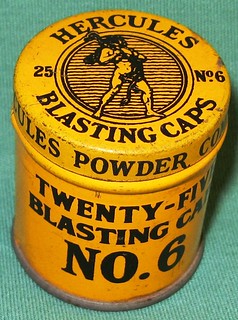 My brother Christopher was born in 1943, and evacuated a year later, with my mum, to Gloucester, during the V1 and V2 raids. He eventually began working at Boehm’s too, though by then it had been taken over by the Hercules Powder Company. He rose to laboratory supervisor before being made redundant when the company moved, and spent the rest of his career doing bar work and greenkeeping at Shooters Hill Golf Club, at exactly the same location where my dad’s rocket battery had been situated, and on the same golf course where my dad passed away. Chris eventually died of motor neurone disease in 2009.
My brother Christopher was born in 1943, and evacuated a year later, with my mum, to Gloucester, during the V1 and V2 raids. He eventually began working at Boehm’s too, though by then it had been taken over by the Hercules Powder Company. He rose to laboratory supervisor before being made redundant when the company moved, and spent the rest of his career doing bar work and greenkeeping at Shooters Hill Golf Club, at exactly the same location where my dad’s rocket battery had been situated, and on the same golf course where my dad passed away. Chris eventually died of motor neurone disease in 2009.
And then there was me, of course, born in this house on Shooters Hill on the 11th of June 1949 (at 2:00pm BST, in case anyone wants to work out my horoscope and perform evil magic against me!), and I’ve pretty much been here ever since. We Moores don’t move around much…
PÓM: I presume you went to school locally as well, then?
SM: It certainly was local – In 1954 I started attending Christ Church Primary School, halfway up Shooters Hill and about 200 yards from my house. It’s been extended since, but at the time it was absolutely tiny. Only 60 pupils, spread over six years; ten pupils per year. There were only two classrooms. The first two years (‘infants’) in one, the other vaguely divided into two, with two teachers, who each taught two years simultaneously.
Thinking back, I realise that my physical world was really quite small as a kid. Although I was theoretically in London (the border with Kent was only a quarter of a mile away), being on top of a hill rather cuts you off from the surrounding territory, and half the hill was covered in woods besides. There were a couple of ‘corner shops’ on the hill, but that was all. If you wanted to get to a shopping centre or cinema, etc., you had to get a bus; and as no one in the family drove we tended to stay home a lot. I don’t actually recall eating in a restaurant at all as a kid, unless we were on holiday. In the summer holidays my mum would take me off to the museums in central London, but that meant both a bus and a train to get there, and I didn’t really spend much time at all in central London until I started working there, aged 17. I suspect that may be why I still, to this day, dream an awful lot about trains and stations: they were the portals to the exciting world of possibilities that London represented.
 On the other hand, living on top of the hill meant that I had enormous horizons – I could see the whole of central and East London – and a very large sky. I think that may have affected my mindset; I may have been pretty much stuck in one place, but both literally and figuratively I could see for miles, and fill up a very large world with my imagination. Which, being fairly solitary, I did. My brother was six years older than me, so he was already at school before I was born and the age gap meant that we never really played together much; it was a bit like being an only child in a two-child family. So I read a lot from quite early on.
On the other hand, living on top of the hill meant that I had enormous horizons – I could see the whole of central and East London – and a very large sky. I think that may have affected my mindset; I may have been pretty much stuck in one place, but both literally and figuratively I could see for miles, and fill up a very large world with my imagination. Which, being fairly solitary, I did. My brother was six years older than me, so he was already at school before I was born and the age gap meant that we never really played together much; it was a bit like being an only child in a two-child family. So I read a lot from quite early on.
->PÓM: What sort of a child were you: quiet, outgoing, or what?
->SM: I’ve really always been introverted rather than extroverted, so I was quiet, shy, occasionally sulky and easily bored. I also found it quite hard to make really close friendships, and as soon as I left primary school I left behind all the friends I’d made there. The same thing happened with grammar school and the job at Rank’s. The really close friendships I’ve tended to make have been based on shared interests, usually creative or scholarly, and they’ve been few and long-lasting. On the other hand, I think with hindsight that I was also a bit hyperactive, though I’m not sure the term had actually been invented then. In my teens and twenties I’d spend more time pacing up and down in my bedroom than sitting down, listening to music, thinking about story ideas, and so on. I suspect that’s reflected in my rather dilettantish shifting of interests over the years.<-
PÓM: And what sort of things were you interested in as a child?
SM: As for early interests, they divided roughly into two. On the one hand, there was the ancient world, and especially mythology – I remember from a very early age having an exercise book in which I’d collect, in my very bad hand-writing (it’s never improved), lists of gods and goddesses from all parts of the world, delighting every time someone gave me a new name to add to my collection. 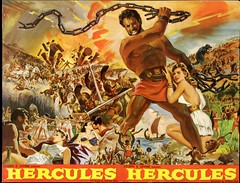 Possibly that sprang from seeing movies like Helen of Troy or the Steve Reeves Hercules movies (for which I still have a lingering affection), but it’s an interest that’s stayed with me ever since. On the other hand, I was also mad for outer space, especially after the first Sputnik went up in 1957 (about which I still have some original newspaper clippings somewhere in the back of a filing cabinet). Although I read some juvenile SF like E.C. Eliott’s Kemlo series and Angus MacVicar’s Lost Planet books, my interests were mainly non-fictional. I was a member of the junior branch of the Royal Astronomical Society and had my own telescopes; I read Patrick Moore’s books; I collected the complete set of 88 Space Cards bubble-gum cards (published by Topps in the States in 1958, and by ABC here), which explained, speculatively but not fictionally, and with painted images after the style of space artist Chesley Bonestell, how mankind would explore and colonise the solar system (I still have them too – quaint, naïve and absolutely gorgeous).
Possibly that sprang from seeing movies like Helen of Troy or the Steve Reeves Hercules movies (for which I still have a lingering affection), but it’s an interest that’s stayed with me ever since. On the other hand, I was also mad for outer space, especially after the first Sputnik went up in 1957 (about which I still have some original newspaper clippings somewhere in the back of a filing cabinet). Although I read some juvenile SF like E.C. Eliott’s Kemlo series and Angus MacVicar’s Lost Planet books, my interests were mainly non-fictional. I was a member of the junior branch of the Royal Astronomical Society and had my own telescopes; I read Patrick Moore’s books; I collected the complete set of 88 Space Cards bubble-gum cards (published by Topps in the States in 1958, and by ABC here), which explained, speculatively but not fictionally, and with painted images after the style of space artist Chesley Bonestell, how mankind would explore and colonise the solar system (I still have them too – quaint, naïve and absolutely gorgeous). 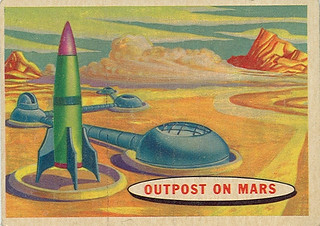 And, of course, there was Dan Dare to read every week. My brother had taken the Eagle since issue one in 1950, and I just grew into it, and we kept having it delivered every week until it closed in 1969 (those, alas, I don’t have any more). As a kid, I used to think ‘I hope I’m still alive in the 21st century’ (which seemed an awfully long way away then), as I was expecting us to have moon bases, and colonies on Mars, and regular spaceflights. Needless to say, the reality has turned out to be a gross disappointment, to put it mildly.
And, of course, there was Dan Dare to read every week. My brother had taken the Eagle since issue one in 1950, and I just grew into it, and we kept having it delivered every week until it closed in 1969 (those, alas, I don’t have any more). As a kid, I used to think ‘I hope I’m still alive in the 21st century’ (which seemed an awfully long way away then), as I was expecting us to have moon bases, and colonies on Mars, and regular spaceflights. Needless to say, the reality has turned out to be a gross disappointment, to put it mildly.
->PÓM: I’m guessing, from what you’re saying, that you are something of a hoarder?
->SM: Pretty much so. Over the years my comics and SF collections got trimmed back so I pretty much only kept the stuff I really loved at the time, but I find it very difficult to get rid of anything, particularly non-fiction books, which I regard as part of my reference library, and which I also want to pass on to the Fortean Times people when I’m gone, as a research aid. And even though I’ve got the entire house to myself now, it’s still packed to the rafters (literally – the loft’s pretty full too!)<-
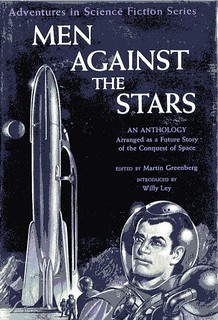 SM: Anyway, that went on until 1960, when I picked up my first adult SF book, an anthology of stories from Astounding called Men Against the Stars, edited by Martin Greenberg, on a holiday in Guernsey. That was quite a life-changing event, as I then spent at least the first half of the 1960s just devouring enormous quantities of SF paperbacks – people like A.E. Van Vogt, Leigh Brackett, Jack Vance, Kenneth Bulmer, New Worlds in the John Carnell era, before it was edited by Mike Moorcock – and although I don’t read a great deal of SF these days, my tastes are still very much influenced by that ‘50s and ‘60s space adventure material. To start with, paperbacks were 2/6d each, and my pocket money was 2/- per week – but by some miracle (or more likely the kindness of my mum) I managed to get a book every week.
SM: Anyway, that went on until 1960, when I picked up my first adult SF book, an anthology of stories from Astounding called Men Against the Stars, edited by Martin Greenberg, on a holiday in Guernsey. That was quite a life-changing event, as I then spent at least the first half of the 1960s just devouring enormous quantities of SF paperbacks – people like A.E. Van Vogt, Leigh Brackett, Jack Vance, Kenneth Bulmer, New Worlds in the John Carnell era, before it was edited by Mike Moorcock – and although I don’t read a great deal of SF these days, my tastes are still very much influenced by that ‘50s and ‘60s space adventure material. To start with, paperbacks were 2/6d each, and my pocket money was 2/- per week – but by some miracle (or more likely the kindness of my mum) I managed to get a book every week. 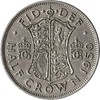 That was pretty much the start of a collecting mania that these days has filled the entire house with books, though now very little of that’s SF. Just as an aside, back then ‘science fiction’ was always abbreviated as ‘SF’, and anyone who said ‘sci-fi’ was considered a hopeless know-nothing. I suspect that as SF has become more mainstream, the media have enforced a more pronounceable abbreviation, but to someone of my age, ‘sci-fi’ (or worse, ‘syfy’) still grates hideously.
That was pretty much the start of a collecting mania that these days has filled the entire house with books, though now very little of that’s SF. Just as an aside, back then ‘science fiction’ was always abbreviated as ‘SF’, and anyone who said ‘sci-fi’ was considered a hopeless know-nothing. I suspect that as SF has become more mainstream, the media have enforced a more pronounceable abbreviation, but to someone of my age, ‘sci-fi’ (or worse, ‘syfy’) still grates hideously.
Still, getting back to my education. I next went, in 1960, to the Roan School, a boys’ grammar school in Greenwich which, even if it was a bus ride away, was still fairly close at hand. I mainly chose it because they played football rather than rugby, which I didn’t fancy at all – mind you, I never actually wanted to play sport anyway. Still, with a greater interest in the past, these days, I’m actually quite pleased that I went to a school with 400 years of history. Influenced by my space and SF background, I ended up in the science stream, took my GCE O Levels a year early, and then embarked on the first year of A levels in biology, chemistry and physics. By then, of course, I’d discovered that what really interested me about science fiction was actually the fiction, not the science – and I was thoroughly fed up with school anyway – so as soon as I was 16 (barely), I was away [so, probably 1965 - PÓM]. 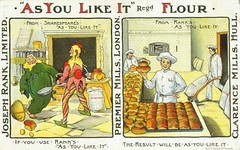 Of course, what little qualification I had was in science subjects, so I ended up working in a laboratory at Rank, Hovis, MacDougall, the flour makers, in Deptford. By the time I’d been there a week, I realised I hated it, but I didn’t know what else to do, so I just retreated further into fantasy – which by then included comics.
Of course, what little qualification I had was in science subjects, so I ended up working in a laboratory at Rank, Hovis, MacDougall, the flour makers, in Deptford. By the time I’d been there a week, I realised I hated it, but I didn’t know what else to do, so I just retreated further into fantasy – which by then included comics.
PÓM: What exactly were you doing at the flour factory?
SM: I was working in the quality control laboratory, attached to the actual mill. We’d get in samples of grain and flour, which needed half a dozen different tests, though I can only remember a couple of them. One was ‘moistures’, where you’d weigh out a certain quantity of the flour into a small, close-topped tin. Then you’d bake a batch of tins in an oven for a couple of hours and weigh them again, and from the difference in the weight you’d work out a percentage for the moisture in the sample that had been driven off in the baking. 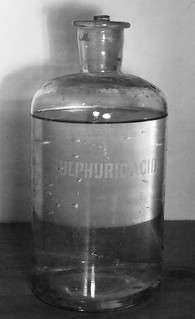 The other was ‘proteins’ which entailed boiling the samples in flasks full of sulphuric acid (but I don’t quite remember the details). You’d spend a week working on one test, then move on to another the next, so you weren’t doing the same thing all the time, but it was all very routine. You see why I wanted to get out of there. About the only good thing about it was that they had a games room where you could spend your lunch hour playing snooker or table tennis. And there was a pub a few yards away…
The other was ‘proteins’ which entailed boiling the samples in flasks full of sulphuric acid (but I don’t quite remember the details). You’d spend a week working on one test, then move on to another the next, so you weren’t doing the same thing all the time, but it was all very routine. You see why I wanted to get out of there. About the only good thing about it was that they had a games room where you could spend your lunch hour playing snooker or table tennis. And there was a pub a few yards away…
PÓM: Do you ever regret leaving school so early?
SM: What’s the point of regret? I made a decision almost 50 years ago and there’s no going back to change it. Seriously, though, there was nothing they could have taught me at school that would have helped me in a career as a comic-strip writer. When I was at Odhams I did a day-release course in journalism for several months, and that was completely useless to me as well. On the last day of the course  I presented the lecturer with a copy of my fanzine, Aspect #2, fully typeset and with a colour cover, with professional artists and writers, and he said ‘Why didn’t you show this to us before?’ The answer being, first, that I already knew all the relevant stuff he’d been trying to teach me and, second, I just didn’t want to, as I’d been bored rigid all the way through the course. I think it might just have been a way of showing my contempt for the course that I’d wasted so much time on.
I presented the lecturer with a copy of my fanzine, Aspect #2, fully typeset and with a colour cover, with professional artists and writers, and he said ‘Why didn’t you show this to us before?’ The answer being, first, that I already knew all the relevant stuff he’d been trying to teach me and, second, I just didn’t want to, as I’d been bored rigid all the way through the course. I think it might just have been a way of showing my contempt for the course that I’d wasted so much time on.
Of course there are times when, considering my non-fiction research interests in the classical and oriental worlds, I think it would perhaps have been useful to have gone to university and learned Greek, Latin or Chinese properly, but hindsight is a wonderful thing. And knowing how much I hated school, I doubt I would have had any better time at university. Or that either of those things would have helped me make a living.
PÓM: Now, I wanted to ask you about comics. What comics were you reading at this stage?
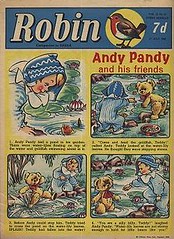 SM: As a very young kid I read Robin, the junior companion to Eagle, and then I think I probably had the same line’s Swift, before working my way up to Eagle itself. I seem to recall reading DC Thomson’s The Beezer for a while when it first started (I was probably seduced by the free gifts given away at its launch) and as I said, I then grew into the Eagle, which was my main boyhood comic. I may have read some other stuff, but I don’t recall reading any of the major boys’ adventure comics like Lion or Tiger. I have vague memories of reading the odd copy of Marvelman and Young Marvelman, probably borrowed from other kids at school, but I wasn’t really into comics at primary school. Too busy reading The Boys’ Book of Space!
SM: As a very young kid I read Robin, the junior companion to Eagle, and then I think I probably had the same line’s Swift, before working my way up to Eagle itself. I seem to recall reading DC Thomson’s The Beezer for a while when it first started (I was probably seduced by the free gifts given away at its launch) and as I said, I then grew into the Eagle, which was my main boyhood comic. I may have read some other stuff, but I don’t recall reading any of the major boys’ adventure comics like Lion or Tiger. I have vague memories of reading the odd copy of Marvelman and Young Marvelman, probably borrowed from other kids at school, but I wasn’t really into comics at primary school. Too busy reading The Boys’ Book of Space!
PÓM: Had American comics started to become readily available, and were you reading them?
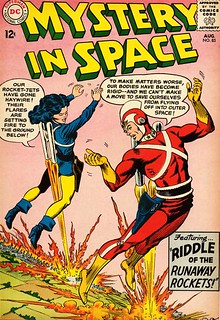 SM: No. I think American comics weren’t imported into this country before 1960, by which time I was at grammar school and reading ‘grown up’ SF. The first American comic I saw was a copy of Mystery in Space, which my mum (knowing my tastes) bought to cheer me up while I was in bed with some minor illness. I liked it (and Adam Strange has always retained a special place in my affections as a result) but, again, the bug didn’t really bite at the time.
SM: No. I think American comics weren’t imported into this country before 1960, by which time I was at grammar school and reading ‘grown up’ SF. The first American comic I saw was a copy of Mystery in Space, which my mum (knowing my tastes) bought to cheer me up while I was in bed with some minor illness. I liked it (and Adam Strange has always retained a special place in my affections as a result) but, again, the bug didn’t really bite at the time.
PÓM: You were part of the very first wave of British comics fandom, I believe. How did that come about, and how did you become involved in it?
SM: Well, first I was involved with British SF fandom, which was long established – from before World War II, I believe. I think it was about 1964 (maybe 1963) that I joined the British Science Fiction Association (BSFA), probably as a result of seeing an advert in something like New Worlds. At the time there was quite a thriving London ‘scene’, particularly Friday evening meetings at the flat of a woman called Ella Parker, who lived in Kilburn, which I started attending regularly. I made a few contacts there and, while it might be too much to say I got to ‘know’ them, I at least got the chance to meet and hang out with authors like Mike Moorcock, John Brunner, Kenneth Bulmer and E.C. Tubb; and sometimes to share the tube back to Charing Cross with the charming John Carnell. Big thrills for a 15-year-old kid – though obviously I was too young to really make a connection with the professional writers.
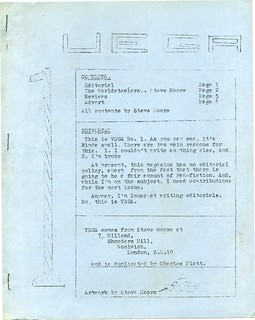 It was through the BSFA that I got to publish my first fanzine, Vega. Things were pretty primitive back then – no computers, no printers, not even any copy shops. The height of amateur printing technology was the Gestetner machine, where you typed on plastic stencils which were then placed on an inked drum and printed from there. If you wanted to reproduce illustrations, you sent them away to someone who’d make ‘electrostencils’ for you. The BSFA ran something called the Publishing And Distribution Service, where you cut your own stencils and sent them in for printing (by future author and critic Charles Platt, who had his own duplicator). I don’t think there were more than about ten members of PADS at the time, but the idea was that you got a few copies of your fanzine for your own use, and there were also copies printed off for the other members, so you’d get an envelope full of everyone else’s fanzines as well.
It was through the BSFA that I got to publish my first fanzine, Vega. Things were pretty primitive back then – no computers, no printers, not even any copy shops. The height of amateur printing technology was the Gestetner machine, where you typed on plastic stencils which were then placed on an inked drum and printed from there. If you wanted to reproduce illustrations, you sent them away to someone who’d make ‘electrostencils’ for you. The BSFA ran something called the Publishing And Distribution Service, where you cut your own stencils and sent them in for printing (by future author and critic Charles Platt, who had his own duplicator). I don’t think there were more than about ten members of PADS at the time, but the idea was that you got a few copies of your fanzine for your own use, and there were also copies printed off for the other members, so you’d get an envelope full of everyone else’s fanzines as well.
Frankly, Vega was embarrassingly awful. The first issue was six pages long, the second and third eight pages. Having no contacts, I wrote the whole of the first two issues – mainly stories and book reviews – though by the time I got to the third issue a couple of other PADS members had taken pity on me and contributed stories. But by then even I couldn’t stand my own magazine any more, so I knocked it on the head – which was probably a relief to all concerned. But looking back, I can see a beginning there: I didn’t so much want to write about SF, I actually wanted to produce it, which was something that carried over into my comics fanzines. Not long after that, I started building up a nice little collection of rejection slips from magazines like New Worlds, but never sold a story at the time.
Charles Platt also published a very classy (and very fat) fanzine called Beyond, which was where, in early 1964, I first read an article about the exciting new Marvel Comics that Stan Lee and Jack Kirby were producing, so I went out and picked up a few, and after that I was lost. For the rest of the 1960s I was collecting everything in sight … mainly Marvel and DC, though I’d look at just about anything … and as it was relatively easy at the time, I soon managed to pick up everything I wanted back to the time when American comics were first imported. But I was always picking up stuff as a ‘reader’ rather than a ‘collector’: it was very nice to have a brand new copy of something, but as for older stuff, so long as I had a copy I could read I really wasn’t fussed about condition and the idea of going out and buying comics as an investment and storing them in mylar bags would have just struck me as ridiculous. Later I picked up some older stuff from the ‘40s and ‘50s, but again condition wasn’t that important to me, and with that stuff I was much more interested in SF comics than superhero material.
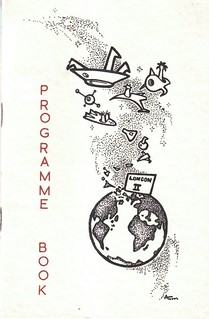 Anyway, my first involvement with comics fandom really came about when I met Phil Clarke at the World Science Fiction Convention [Loncon II] in London, in 1965. We were a couple of 16-year-olds and hung out that weekend, and from that developed a close friendship that lasted several years. At the time, of course, everyone basically kept in touch by letter, but every now and then I’d go to Birmingham to see him, or he’d come to London to see me. And before too long we’d decided to produce a comics fanzine together. I think we might have seen a couple of American examples, but at the time there was nothing over here.
Anyway, my first involvement with comics fandom really came about when I met Phil Clarke at the World Science Fiction Convention [Loncon II] in London, in 1965. We were a couple of 16-year-olds and hung out that weekend, and from that developed a close friendship that lasted several years. At the time, of course, everyone basically kept in touch by letter, but every now and then I’d go to Birmingham to see him, or he’d come to London to see me. And before too long we’d decided to produce a comics fanzine together. I think we might have seen a couple of American examples, but at the time there was nothing over here.
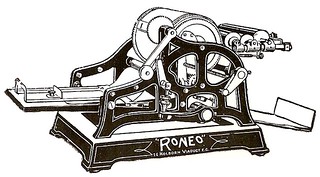 I then acquired a Roneo spirit duplicator, which is just about the most primitive form of printing you can get. Essentially, you’d have a ‘master’ sheet of paper with an ink sheet attached, like carbon paper, facing the back of the master. So you’d then type or draw on the master, and you’d end up with a reversed ink impression on the back of it – the standard ink being purple, though you could get other colours. The master would then go on the drum of the duplicator and be dampened by pure alcohol, which would dissolve just enough of the ink to print the image or text. It was hand-cranked, one page at a time, smelled appalling, and was good for maybe 50 or 60 copies per master. And, of course, if you left the pages in direct light for too long, they faded horribly. So that’s what I printed Ka-Pow with.
I then acquired a Roneo spirit duplicator, which is just about the most primitive form of printing you can get. Essentially, you’d have a ‘master’ sheet of paper with an ink sheet attached, like carbon paper, facing the back of the master. So you’d then type or draw on the master, and you’d end up with a reversed ink impression on the back of it – the standard ink being purple, though you could get other colours. The master would then go on the drum of the duplicator and be dampened by pure alcohol, which would dissolve just enough of the ink to print the image or text. It was hand-cranked, one page at a time, smelled appalling, and was good for maybe 50 or 60 copies per master. And, of course, if you left the pages in direct light for too long, they faded horribly. So that’s what I printed Ka-Pow with.
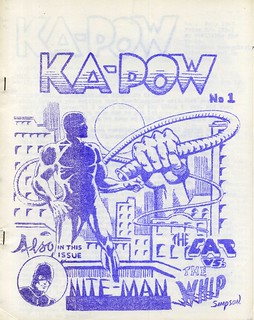 Frankly, my memories of this period are pretty vague now. Hunting out the old issues of Ka-Pow, it became obvious to me that we’d prepared masters of interior pages for a first issue, which are dated April 1966, but this was never published – though obviously I ran off at least one print from them, as I still have it. I suspect we just weren’t happy with it. But we eventually released the first, much improved issue in July 1967. As far as I know, that was the first British comics fanzine, though Tony Roche’s Merry Marvel Fanzine, published in Ireland, was a little earlier. By then we’d met a pretty good fan artist from Durham called Ken Simpson (though I’m not sure if he ever made it professionally), who contributed a cover and a strip called ‘The Cat’ while I, under the absurd delusion that I might be able to draw, did a strip called ‘Nite-Man’, and there was a text-story called ‘American Eagle’ by ‘John James’, which I think was me (at least, it was a pseudonym I used later when contributing an article to the men’s magazine Game about women fighters in kung fu movies), although it could have been Phil and I together. I suspect it was just a move to make it look like we had more contributors! And Phil and I both did articles about old time British comics. The line up was pretty much the same for the second issue (February 1968), except the article (on Tarzan strips) was by Gerald Cleaver. That was printed on the Roneo again and, frankly, large parts of my copy are now unreadable!
Frankly, my memories of this period are pretty vague now. Hunting out the old issues of Ka-Pow, it became obvious to me that we’d prepared masters of interior pages for a first issue, which are dated April 1966, but this was never published – though obviously I ran off at least one print from them, as I still have it. I suspect we just weren’t happy with it. But we eventually released the first, much improved issue in July 1967. As far as I know, that was the first British comics fanzine, though Tony Roche’s Merry Marvel Fanzine, published in Ireland, was a little earlier. By then we’d met a pretty good fan artist from Durham called Ken Simpson (though I’m not sure if he ever made it professionally), who contributed a cover and a strip called ‘The Cat’ while I, under the absurd delusion that I might be able to draw, did a strip called ‘Nite-Man’, and there was a text-story called ‘American Eagle’ by ‘John James’, which I think was me (at least, it was a pseudonym I used later when contributing an article to the men’s magazine Game about women fighters in kung fu movies), although it could have been Phil and I together. I suspect it was just a move to make it look like we had more contributors! And Phil and I both did articles about old time British comics. The line up was pretty much the same for the second issue (February 1968), except the article (on Tarzan strips) was by Gerald Cleaver. That was printed on the Roneo again and, frankly, large parts of my copy are now unreadable!
 The third and last issue (August 1968) was all litho, which again I think was a first for this country, and featured strips by Mike Higgs, Ken Simpson and John Hudson (I’d learned my lesson by this point). I don’t know why we stopped – I suspect we may just have run out of steam. I was eventually involved in a couple more fanzines, but they come a little later in the story.
The third and last issue (August 1968) was all litho, which again I think was a first for this country, and featured strips by Mike Higgs, Ken Simpson and John Hudson (I’d learned my lesson by this point). I don’t know why we stopped – I suspect we may just have run out of steam. I was eventually involved in a couple more fanzines, but they come a little later in the story.
By then, of course, there were a number of other comics fanzines, and it was standard practice to trade issues and adverts with other editors, which was pretty much how the whole fan publishing network built up. 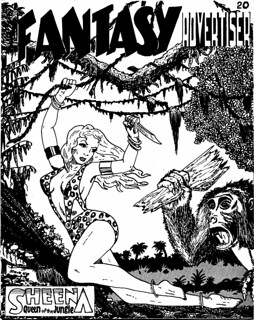 Another good friend I made at the time was Frank Dobson, original publisher of the adzine Fantasy Advertiser, who lived not far from me in Lewisham. And although I’d realised by then that I couldn’t actually draw, I could still swipe, so I did most of Frank’s covers in 1968 and 1969, being basically pin-up pictures of favourite costumed characters. Frank was very good to me in that period. At weekends we’d jump in his van and go round the market stalls in London, where it was still possible to pick up second hand comics, Frank looking for stock and I for stuff for my collection, and there was never any competition. If I found something I wanted it was mine, even if it might have been something that Frank could have sold for a fair amount. He was a great EC collector, always looking to improve the quality of his collection by trading with dealers in the States; and, of course, EC had only gone out of business a dozen years before at that time. So if he’d got a pristine copy of something to replace a poorer one, he’d pass that on to me for about half the price he’d sell it in FA – which was great because, as I said, I wasn’t that fussed about condition. So I got quite a nice collection of original EC Comics really cheap, particularly the SF titles, which were obviously the ones I was most interested in.
Another good friend I made at the time was Frank Dobson, original publisher of the adzine Fantasy Advertiser, who lived not far from me in Lewisham. And although I’d realised by then that I couldn’t actually draw, I could still swipe, so I did most of Frank’s covers in 1968 and 1969, being basically pin-up pictures of favourite costumed characters. Frank was very good to me in that period. At weekends we’d jump in his van and go round the market stalls in London, where it was still possible to pick up second hand comics, Frank looking for stock and I for stuff for my collection, and there was never any competition. If I found something I wanted it was mine, even if it might have been something that Frank could have sold for a fair amount. He was a great EC collector, always looking to improve the quality of his collection by trading with dealers in the States; and, of course, EC had only gone out of business a dozen years before at that time. So if he’d got a pristine copy of something to replace a poorer one, he’d pass that on to me for about half the price he’d sell it in FA – which was great because, as I said, I wasn’t that fussed about condition. So I got quite a nice collection of original EC Comics really cheap, particularly the SF titles, which were obviously the ones I was most interested in.
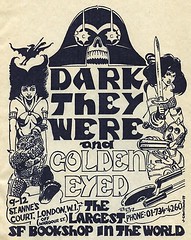 Probably the most important other friend I made at this time was Derek ‘Bram’ Stokes, future owner of Dark They Were and Golden Eyed, the first specialist SF and comics shop in the country (and, I’m not sure, possibly in the world). I think I first met Derek at an SF convention where he was regarded by the more straight fans, many of whom could be surprisingly conservative, as a long-haired weirdo (particularly when he turned up for the fancy dress as a barbarian, wearing little more than a sword-belt and a translucent scarf as a ‘loin cloth’), but I rather took to him. He was hip, and it was the Sixties, and we had a lot of fun. At the time he was running a mail order business for SF, horror and comics called The Vault of Horror from a lock-up in North London, but eventually he decided to open a shop. I remember him coming over to my place with a couple of young ladies called Eileen and Cathy, and we then all sat on my dining room floor (as one did in those days) discussing a name for the place. There were two options: to call it after the fairy tale collection East of the Sun and West of the Moon, which I actually favoured, but the other three outvoted me and it ended up as DTWAGE, after the Ray Bradbury story.
Probably the most important other friend I made at this time was Derek ‘Bram’ Stokes, future owner of Dark They Were and Golden Eyed, the first specialist SF and comics shop in the country (and, I’m not sure, possibly in the world). I think I first met Derek at an SF convention where he was regarded by the more straight fans, many of whom could be surprisingly conservative, as a long-haired weirdo (particularly when he turned up for the fancy dress as a barbarian, wearing little more than a sword-belt and a translucent scarf as a ‘loin cloth’), but I rather took to him. He was hip, and it was the Sixties, and we had a lot of fun. At the time he was running a mail order business for SF, horror and comics called The Vault of Horror from a lock-up in North London, but eventually he decided to open a shop. I remember him coming over to my place with a couple of young ladies called Eileen and Cathy, and we then all sat on my dining room floor (as one did in those days) discussing a name for the place. There were two options: to call it after the fairy tale collection East of the Sun and West of the Moon, which I actually favoured, but the other three outvoted me and it ended up as DTWAGE, after the Ray Bradbury story.
->PÓM: Did you have many girlfriends at the time?
->SM: The short answer to that is no. Having been to a boys’ grammar school, and with my usual sort of stay-at-home lifestyle, I hardly had any contact with girls before I left school. The first time I asked one out was when I was already working at Rank’s. But besides my rather sheltered upbringing, I don’t think we matured as early then as kids do these days.
I got to know Eileen and Cathy as friends of Derek. They were part of a larger group of friends who gathered around the beginnings of DTWAGE (I think Cathy worked in the shop for a while), and we’d hang out together, smoke dope, go to concerts, and do all those other things people did in the late ‘60s – including getting together to sit on floors and talk about weird shop names. Later, of course, there were other ladies I was very fond of, but they all tended to be on a one-at-a-time basis. ‘Many girlfriends’, though – no.<-
SM: Derek’s first shop, a tiny place with its frontage painted a wonderful deep purple, opened in Bedfordbury, on the edge of Covent Garden, in, I think, 1970. I painted a pair of big, golden-pupilled eyes in the front window for him. I seem to recall doing this in black and gold gloss paint, so how the next owners of the shop actually got them off again, I’m not sure! Eventually he moved to larger premises in Berwick Street, and finally, and most famously, to an impressively large shop in St. Anne’s Court. That was pretty much my second home in the late seventies. By then I was freelance, and if the work was a bit short I’d go in a couple of days and work behind the counter – and at other times I’d just go in there and hang out, make cups of tea for the staff, etc. When it finally closed in 1981 I felt like I’d lost an enormously important part of my life, and a lot of good friends. But Derek ended up in Lancaster, and I just lost touch with him.
->PÓM: What else were you interested in in your teens and twenties? Music, cinema, television, anything like that?
 ->SM: Ah, now you really want me to show my age! The first record I owned was a 78 of Elvis Presley singing Hound Dog and, when he was still singing rock’n’roll in the late ‘50s, I quite liked Cliff Richard too (but please don’t use this in evidence against me – surely the statute of limitations must have run out on that one by now!) though I was actually much more interested in The Shadows, and an underlying interest in instrumental music, rather than songs, has remained with me ever since. From there I moved to the American guitar band, The Ventures, which in turn led my interest toward surf music for a while. I listened to The Beatles, but was much more fond of the Rolling Stones (their first album was the first LP I bought), but the band I really loved in the ‘60s was The Yardbirds, especially in their Jeff Beck period. Again, the guitar solos were a considerable attraction, but from there I developed a liking for blues, bands like Cream and some British psychedelia, and then for several years around the late ‘60s and early ‘70s I was into West Coast bands like the Grateful Dead and Quicksilver Messenger Service where, again, the emphasis was on extended soloing.
->SM: Ah, now you really want me to show my age! The first record I owned was a 78 of Elvis Presley singing Hound Dog and, when he was still singing rock’n’roll in the late ‘50s, I quite liked Cliff Richard too (but please don’t use this in evidence against me – surely the statute of limitations must have run out on that one by now!) though I was actually much more interested in The Shadows, and an underlying interest in instrumental music, rather than songs, has remained with me ever since. From there I moved to the American guitar band, The Ventures, which in turn led my interest toward surf music for a while. I listened to The Beatles, but was much more fond of the Rolling Stones (their first album was the first LP I bought), but the band I really loved in the ‘60s was The Yardbirds, especially in their Jeff Beck period. Again, the guitar solos were a considerable attraction, but from there I developed a liking for blues, bands like Cream and some British psychedelia, and then for several years around the late ‘60s and early ‘70s I was into West Coast bands like the Grateful Dead and Quicksilver Messenger Service where, again, the emphasis was on extended soloing. 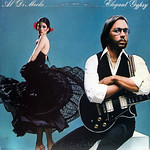 By the mid ‘70s I was turning to jazz-rock, and people like Al DiMeola and Jean-Luc Ponty, and since then I’ve had phases of classical, Elizabethan harpsichord, world music, and so on. In all this stuff it tends to be the music that interests me rather than lyrics, possibly because I tend to listen to music more when I’m doing other things as well, so I don’t really want to be distracted by songs. And I have a great love of complexity; I tend to go back to things like Scarlatti harpsichord sonatas, or Paco Peňa playing classic flamenco guitar.
By the mid ‘70s I was turning to jazz-rock, and people like Al DiMeola and Jean-Luc Ponty, and since then I’ve had phases of classical, Elizabethan harpsichord, world music, and so on. In all this stuff it tends to be the music that interests me rather than lyrics, possibly because I tend to listen to music more when I’m doing other things as well, so I don’t really want to be distracted by songs. And I have a great love of complexity; I tend to go back to things like Scarlatti harpsichord sonatas, or Paco Peňa playing classic flamenco guitar.
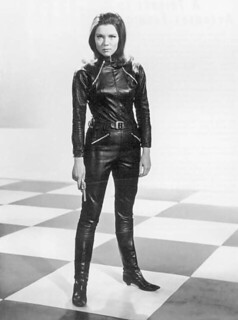 As for TV, I remember watching the BBC serial of Quatermass and the Pit, literally from behind the sofa as it scared me so much (mind you, I was only nine at the time). I really liked The Man from U.N.C.L.E., but the main series that impressed me in the ‘60s were The Avengers (particularly the Diana Rigg period) and The Prisoner. I never really took to Doctor Who, probably because the first series featured William Hartnell and a girl supposed to be his granddaughter, and I never liked programmes with kids in, so I swiftly gave up on it, and never really watched it until I actually had to write the character as a comic strip. And there was other stuff, of course, that I don’t remember. But I think that, generally, we watched far more TV in those days when we only had two channels than we do now, when the choice is almost infinite.
As for TV, I remember watching the BBC serial of Quatermass and the Pit, literally from behind the sofa as it scared me so much (mind you, I was only nine at the time). I really liked The Man from U.N.C.L.E., but the main series that impressed me in the ‘60s were The Avengers (particularly the Diana Rigg period) and The Prisoner. I never really took to Doctor Who, probably because the first series featured William Hartnell and a girl supposed to be his granddaughter, and I never liked programmes with kids in, so I swiftly gave up on it, and never really watched it until I actually had to write the character as a comic strip. And there was other stuff, of course, that I don’t remember. But I think that, generally, we watched far more TV in those days when we only had two channels than we do now, when the choice is almost infinite.
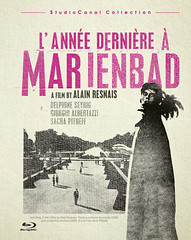 As for movies, like I said, I was brought up on late ‘50s sword-and-sandal epics, which I couldn’t get enough of. In my later teens I was fond of Hammer films, and still have some affection for that comfortable, non-threatening Gothic supernaturalism; whereas I wouldn’t dream of watching a modern horror film, most of which seem to be about horrible ways of murdering people or torture-porn. And while I was working with Steve Parkhouse at IPC, we’d often go off to the British Film Theatre or the Electric Cinema in Notting Hill, and watch European art movies like Last Year in Marienbad and The Seventh Seal, and Japanese samurai movies, though considering where we saw them, these were mostly the up-market productions of people like Kurosawa and Kobayashi. And then in January 1972, Bob Rickard introduced me to the Hong Kong and Taiwan historical swordfighting movie which, again, caused a major shift in my life.
As for movies, like I said, I was brought up on late ‘50s sword-and-sandal epics, which I couldn’t get enough of. In my later teens I was fond of Hammer films, and still have some affection for that comfortable, non-threatening Gothic supernaturalism; whereas I wouldn’t dream of watching a modern horror film, most of which seem to be about horrible ways of murdering people or torture-porn. And while I was working with Steve Parkhouse at IPC, we’d often go off to the British Film Theatre or the Electric Cinema in Notting Hill, and watch European art movies like Last Year in Marienbad and The Seventh Seal, and Japanese samurai movies, though considering where we saw them, these were mostly the up-market productions of people like Kurosawa and Kobayashi. And then in January 1972, Bob Rickard introduced me to the Hong Kong and Taiwan historical swordfighting movie which, again, caused a major shift in my life.
->PÓM: Do you read any recent SF, or is it more what you used to read when you were younger that you go back to?
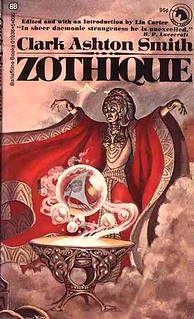 ->SM: No, I haven’t ready any current SF for a long time. When the ‘New Wave’ came along in the late 1960s, I started to lose interest. I’d always loved escapist space opera, and the New Wave stuff was much more contemporary and concerned with current ‘issues’. Like a lot of people at the time, I turned away from that (although I appreciated some of the fine writing by New Wave authors) and got into the burgeoning sword-and-sorcery/fantasy field, and the Weird Tales authors; particularly Clark Ashton Smith. The more traditional SF authors started turning out ‘hard’ SF, but whenever I looked at that stuff it just seemed to me like a lecture in astrophysics, which didn’t appeal to me, despite my boyhood interests; and by the 1970s I was moving into other areas anyway. Occasionally in recent years I’ve gone back and reread a few of my favourite ‘50s and ‘60s authors, but that’s really just a nostalgia trip. Apart from that, I don’t really intersect with SF at all these days.<-
->SM: No, I haven’t ready any current SF for a long time. When the ‘New Wave’ came along in the late 1960s, I started to lose interest. I’d always loved escapist space opera, and the New Wave stuff was much more contemporary and concerned with current ‘issues’. Like a lot of people at the time, I turned away from that (although I appreciated some of the fine writing by New Wave authors) and got into the burgeoning sword-and-sorcery/fantasy field, and the Weird Tales authors; particularly Clark Ashton Smith. The more traditional SF authors started turning out ‘hard’ SF, but whenever I looked at that stuff it just seemed to me like a lecture in astrophysics, which didn’t appeal to me, despite my boyhood interests; and by the 1970s I was moving into other areas anyway. Occasionally in recent years I’ve gone back and reread a few of my favourite ‘50s and ‘60s authors, but that’s really just a nostalgia trip. Apart from that, I don’t really intersect with SF at all these days.<-
To Be Continued…

A week after celebrating his 90th birthday, Silver Age great Dick Ayers has passed away, according to reports on Facebook. TwoMorrow’s David Spurlock passed along a brief obituary and the picture below:
Rest In Peace Dick Ayers. There have never been sweeter people than Dick and his wife Lindy. Here is a photo from one of my recent visits in which Dick and I collaborated on a few recreations of early, Marvel covers by the team of Kirby and Ayers. Richard “Dick” Ayers (born April 28, 1924) is an American comic book artist and cartoonist best known for his work as one of Jack Kirby’s inkers during the late-1950s and 1960s period known as the Silver Age of Comics, including on some of the earliest issues of Marvel Comics’ The Fantastic Four. He is the signature penciler of Marvel’s World War II comic Sgt. Fury and his Howling Commandos, drawing it for 10-year run, and he co-created Magazine Enterprises’ 1950s Western-horror character the Ghost Rider, a version of which he would draw for Marvel in the 1960s. Ayers was inducted into the Will Eisner Comic Book Hall of Fame in 2007.
Ayers was a regular figure at conventions up until recently, and as I was just writing last week about Al Feldstein, a living connection to the history books.





One of the last living EC Comics titans has passed away: Al Feldstein has died at age 88. Feldstein was one of the main architects of the EC Comics legend, writing some of its signature stories and editing Mad Magazine for 28 years after the departure of founder Harvey Kurtzman.
Feldstein still recreated artwork from his EC days and until his health began to fail was a frequent guest at shows — and he had a prolific mailing list where he opined on various political topics from a liberal point of view.
As a writer, Feldstein was responsible for a lot of EC’s output—while the famed stable of artists gets most of the fame these days, it’s hard to underestimate Feldstein’s contributions, which I’m sure will be much discussed in the new few days.

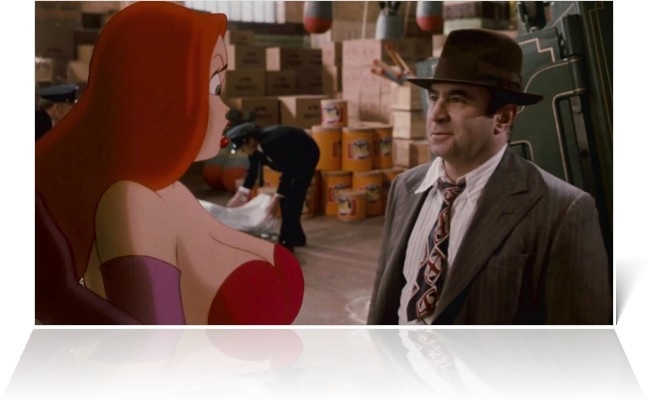
One of the groundbreaking performances in CGI history and a memorable actor overall.
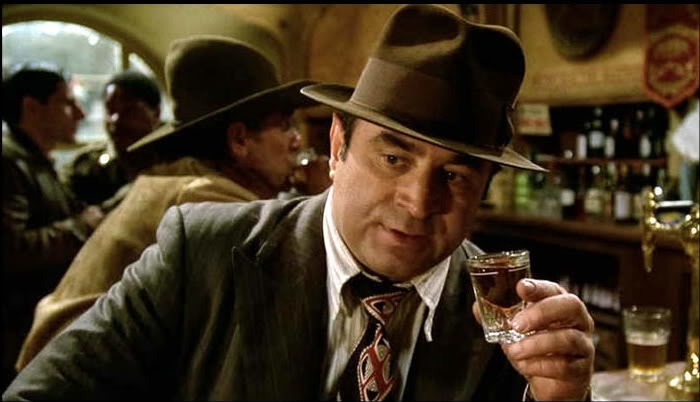
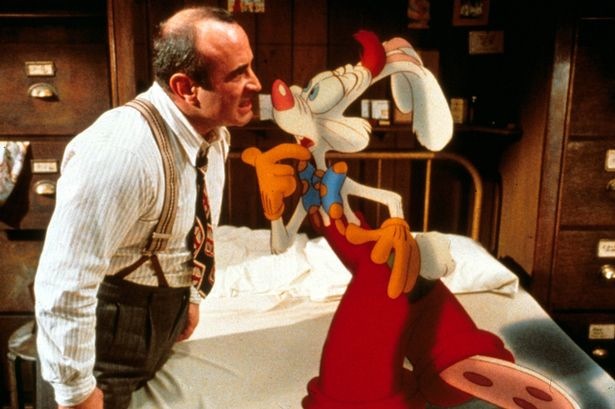
 Columbian author Gabriel García Márquez has passed away. He was 87-years-old.
Columbian author Gabriel García Márquez has passed away. He was 87-years-old.
In 2012, Márquez’s brother Jaime revealed that the beloved writer was suffering from dementia. Earlier this month, he was hospitalized in Mexico City.
Throughout his career, Márquez wrote nonfiction, short stories, news articles, and novels including his best known works, One Hundred Years of Solitude (1967) and Love in the Time of Cholera (1985). In 1982, he won the the Nobel Prize in Literature and accepted the award by delivering his now famous speech, “The Solitude of Latin America.” (via Latin Times)
New Career Opportunities Daily: The best jobs in media.
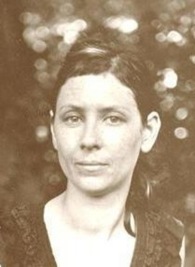
Designer Courtney Utt, who was responsible for some of Viz’s most distinctive covers, passed away recently at the age of just 37 following a long battle with brain cancer.
You can see much of Utt’s work here.
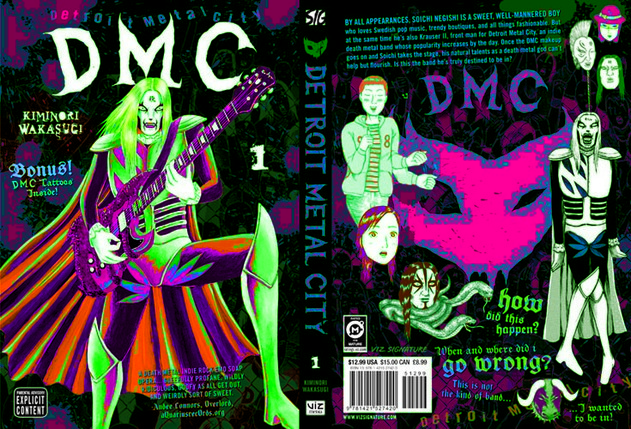
Only a day after recording this promo, the man known as The Ultimate Warrior is dead at age 54.

Born Jim Hellwig, the masked wrestler eventually changed his name legally to Warrior. One of wrestling greatest icons from its 80s glory days, The Ultimate Warrior brought unmatched ferocity and craziness to his matches and promos. He was a comic book character brought to life.
After being on the outs for nearly 18 years with the WWE—at one point they even released an entire DVD devoted to showing how erratic he was in real life—Warrior had made a return just in the last few days, including a NEW three year contract to be a brand ambassador for the WWE. On Saturday, the 5th, he was iducted into the WWE Hall of Fame. On Sunday he appeared at Wrestlemania. On Monday he cut the above promo on Raw. And on Tuesday…he passed away.
Details weren’t known as I write this but suffice to say…wrestling is a very very difficult way to make a living.

The Ultimate Warrior at his WWE Hall of Fame Induction. (Photo: Jonathan Bachman, AP Images for WWE)
Stephen James Moore was born at 2:00pm on June 11th, 1949, in a house on Shooters Hill in South London, where he lived all of his life, and died on or around the 16th of March, 2014, still in that house on the hill. In between, he produced a huge body of work, of a very high standard, most of it written in that same house. He was a hugely private man, but his life and mine intersected over the past few years, and I got to learn a lot about him in that brief time. 
But, actually, I was aware of Steve Moore’s work long before that. I had only ever been a desultory reader, at best, of 2000 AD, where he wrote a multitude of short sharp tales, but it’s probably not an exaggeration to say that Warrior, where he was a vital component both in front of and behind the curtain, changed my life. However, I had probably been reading his uncredited work in British comics for years before that, all unknown.
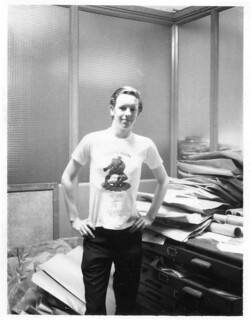 After leaving school at the age of 16, Steve spent a year and a half working in a laboratory in a flour mill, before started at Odhams Press as a Junior Office Boy, in their offices at 64 Long Acre, on 1st May 1967, and within three months was promoted to junior sub-editor on Pow! and Fantastic. The first story he sold professionally was a three-page ‘Pow Short Story’ called The House in the Haunted Swamp, that appeared in Pow! #45, late in 1967, when I would have been turning eight years old, and was undoubtedly reading Pow!, or comics like it. He went on to work on editorially and write stories for several different UK comics, including Whizzer & Chips, Valiant, and Cor!!, with its two exclamation marks. Eventually, in 1972, he left the security of fulltime employment to become a freelance writer, a career he pursued for nearly forty years thereafter.
After leaving school at the age of 16, Steve spent a year and a half working in a laboratory in a flour mill, before started at Odhams Press as a Junior Office Boy, in their offices at 64 Long Acre, on 1st May 1967, and within three months was promoted to junior sub-editor on Pow! and Fantastic. The first story he sold professionally was a three-page ‘Pow Short Story’ called The House in the Haunted Swamp, that appeared in Pow! #45, late in 1967, when I would have been turning eight years old, and was undoubtedly reading Pow!, or comics like it. He went on to work on editorially and write stories for several different UK comics, including Whizzer & Chips, Valiant, and Cor!!, with its two exclamation marks. Eventually, in 1972, he left the security of fulltime employment to become a freelance writer, a career he pursued for nearly forty years thereafter.
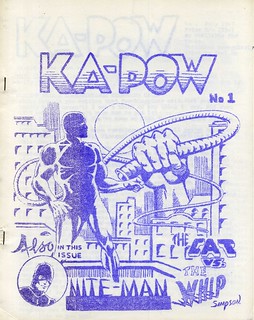 Before all this, though, he had been very active in British SF and comics’ fandom, attending meetings of SF fans in London in his teens, where he met writers like Michael Moorcock, John Brunner, Kenneth Bulmer and E.C Tubb, and made his first steps in publishing fanzines, on some very primitive copying technology. After attending Worldcon in London in 1965, he became involved in comics fandom, and in July 1967 he published Ka-Pow, the first British comics fanzine (although the actual first comics ‘zine on this side of the Atlantic was Merry Marvel Fanzine, published by Irishman Tony Roche, who lived in Dun Laoghaire, a once-posh-but-now-dilapidated suburb of Dublin where I was also living, but was still only seven years old, so completely unaware that history was being made, just down the road from me). Further ‘zines followed, and contacts were made with all sorts of people who would later go on to become important names in UK comics, as well as further afield.
Before all this, though, he had been very active in British SF and comics’ fandom, attending meetings of SF fans in London in his teens, where he met writers like Michael Moorcock, John Brunner, Kenneth Bulmer and E.C Tubb, and made his first steps in publishing fanzines, on some very primitive copying technology. After attending Worldcon in London in 1965, he became involved in comics fandom, and in July 1967 he published Ka-Pow, the first British comics fanzine (although the actual first comics ‘zine on this side of the Atlantic was Merry Marvel Fanzine, published by Irishman Tony Roche, who lived in Dun Laoghaire, a once-posh-but-now-dilapidated suburb of Dublin where I was also living, but was still only seven years old, so completely unaware that history was being made, just down the road from me). Further ‘zines followed, and contacts were made with all sorts of people who would later go on to become important names in UK comics, as well as further afield.
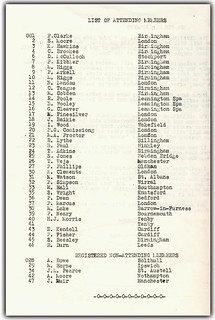 In August 1968 Steve Moore organised, along with Phil Clarke and Kay Hawkins, Clarke’s then-girlfriend, Comicon ’68, Britain’s first comics’ convention, held in the Midland Hotel in Birmingham. The registered attendance was less than fifty people, but these included comics artists Paul Neary, Mike Higgs and Jim Baikie, and Nick Landau and Mike Lake, who would go on to found Titan Distribution, open the London-based Forbidden Planet comic shops, and publish black and white comics reprint volumes as Titan Books. Also in attendance, although not listed on the membership list, was Derek Stokes, universally known as Bram, who went on to open legendary London bookshop and counter-culture hangout, Dark They Were and Golden Eyed. One other name on that membership list, although only in a non-attending and supporting capacity, was a fifteen-year-old Alan Moore, of whom we shall hear more later. A second comic convention followed, in 1969, called, obviously enough, Comicon ’69, which Steve was also on the committee of, after which he decided that the convention life was not for him, and not only retired from con-running, but from con attending as well, and became a self-professed recluse, certainly as far as attending public events relating to either SF of comics were concerned. But attendees at that second con included Alan Moore, Steve Parkhouse, Barry (Windsor) Smith and Bob Rickard, who we will also hear more of later.
In August 1968 Steve Moore organised, along with Phil Clarke and Kay Hawkins, Clarke’s then-girlfriend, Comicon ’68, Britain’s first comics’ convention, held in the Midland Hotel in Birmingham. The registered attendance was less than fifty people, but these included comics artists Paul Neary, Mike Higgs and Jim Baikie, and Nick Landau and Mike Lake, who would go on to found Titan Distribution, open the London-based Forbidden Planet comic shops, and publish black and white comics reprint volumes as Titan Books. Also in attendance, although not listed on the membership list, was Derek Stokes, universally known as Bram, who went on to open legendary London bookshop and counter-culture hangout, Dark They Were and Golden Eyed. One other name on that membership list, although only in a non-attending and supporting capacity, was a fifteen-year-old Alan Moore, of whom we shall hear more later. A second comic convention followed, in 1969, called, obviously enough, Comicon ’69, which Steve was also on the committee of, after which he decided that the convention life was not for him, and not only retired from con-running, but from con attending as well, and became a self-professed recluse, certainly as far as attending public events relating to either SF of comics were concerned. But attendees at that second con included Alan Moore, Steve Parkhouse, Barry (Windsor) Smith and Bob Rickard, who we will also hear more of later.
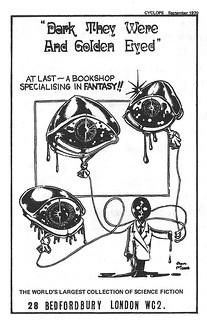 Derek ‘Bram’ Stokes opened Dark They Were and Golden Eyed in Bedfordbury, just beside Covent Garden, in 1970 and, soon afterwards, fantasy writer Stan Nicholls opened Bookends in Notting Hill in 1971. When Steve Moore went freelance in 1972, he was invited to buy into Bookends, and after parting with £500, he found himself as part owner of a SF bookshop, which also came with a room in the basement full of comics, where he could write in between serving customers. Some of what he wrote was for an editor called John Barraclough, who had just launched a comic called Target for New English Library, and took comics stories from Steve than included a four-part horror-thriller called The Curse of the Faceless Man, and a sword-and-sorcery strip called Orek the Outlander, as well as text serial stories in all sorts of genres, including The Horror in the Churchyard and The Scourge of Planet X. At the same time, Barraclough was supplying a Swedish comics company with Tarzan stories, which Steve turned his hand to. There were also a few serials for IPC girls’ comic, Mirabelle, which he didn’t even get to see in their finished form, as IPC didn’t send out copies, and he was too embarrassed to go and buy copies himself. Everything seemed to be going swimmingly, but it turned out that it really was all too good to be true. The Obscene Publication Squad raided Bookends in late 1973, and, between one thing and another, the shop went to the wall, with £5000 worth of debt, which Steve Moore ended up having to mostly repay himself, while Stan Nicholls ended up in Dark They Were and Golden Eyed, so at least their friendship endured, for a while, until Nicholls decamped to Landau and Lake’s Forbidden Planet shop.
Derek ‘Bram’ Stokes opened Dark They Were and Golden Eyed in Bedfordbury, just beside Covent Garden, in 1970 and, soon afterwards, fantasy writer Stan Nicholls opened Bookends in Notting Hill in 1971. When Steve Moore went freelance in 1972, he was invited to buy into Bookends, and after parting with £500, he found himself as part owner of a SF bookshop, which also came with a room in the basement full of comics, where he could write in between serving customers. Some of what he wrote was for an editor called John Barraclough, who had just launched a comic called Target for New English Library, and took comics stories from Steve than included a four-part horror-thriller called The Curse of the Faceless Man, and a sword-and-sorcery strip called Orek the Outlander, as well as text serial stories in all sorts of genres, including The Horror in the Churchyard and The Scourge of Planet X. At the same time, Barraclough was supplying a Swedish comics company with Tarzan stories, which Steve turned his hand to. There were also a few serials for IPC girls’ comic, Mirabelle, which he didn’t even get to see in their finished form, as IPC didn’t send out copies, and he was too embarrassed to go and buy copies himself. Everything seemed to be going swimmingly, but it turned out that it really was all too good to be true. The Obscene Publication Squad raided Bookends in late 1973, and, between one thing and another, the shop went to the wall, with £5000 worth of debt, which Steve Moore ended up having to mostly repay himself, while Stan Nicholls ended up in Dark They Were and Golden Eyed, so at least their friendship endured, for a while, until Nicholls decamped to Landau and Lake’s Forbidden Planet shop.
Meanwhile, in another part of his life, Bob Rickard, who he’d met through various fannish activities in 1968, was about to change Steve Moore’s life, forever. Rickard had discovered that the Odeon cinema in Birmingham was showing Chinese movies at one o’clock in the morning, so that Chinese restaurant staff could see them after work. He brought Steve to see a film called The Sword, starring Wang Yu, and he was hooked, immediately. This would lead to Steve seeing as many of those Hong Kong and Taiwan produced movies as he could, and eventually writing about them, and Chinese culture in general. He spent a large amount of his leisure time in the early and mid-1970s hanging around in Chinese cinema-clubs in the Chinatown area around Gerrard Street in London, and still had some of the lobby cards and posters he managed to persuade the staff to give him. Eventually this led him to the I Ching (more correctly Yijing, as the preferred spelling is these days), or Book of Changes, which became a major area of scholarship for him, leading to his writing the non-fiction The Trigrams of Han, published by HarperCollins in 1989, which was well-liked by fellow scholars, but made him no actual money, to speak of. He also joined the I Ching Society in London, more for the publications than the meetings, and soon took over production of their journal, The Oracle. He ended up as a Fellow of the Royal Asiatic Society, and was one of the main contributors to I Ching: An Annotated Bibliography, an exhaustive 350-page analysis of the subject, published by Routledge in 2002, and continued contributing to both scholarship and debate in the field, right up to the present day.
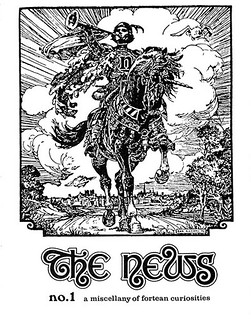 Another consequence of his friendship with Bob Rickard was that he became involved with the fledgling Fortean Times – originally just called The News, back in November 1973, when it started, but changed to its current name in June 1976 – for whom he clipped odd news stories (as would I, and many others, years later), wrote on Oriental phenomena, and soon became a contributing editor, reviewer, and general occasionally-paid helper-out. Because of Steve’s long friendship with Bram Stokes, the Fortean Times people began meeting in a room above Dark They Were and Golden Eyed, until the shop closed down in 1981. None the less, forty and more years after it started, he would still meet up with the rest of the FT helpers every few weeks, to sort out all those clipping people sent in, and keep in touch. During those forty years, he worked as editor, indexer, and contributor on a large number of books relating to the magazine, including – but not limited to – six volumes of Fortean Studies, thirteen collected volumes of the magazine, and a number of compilations of clippings, with titles like Fortean Times Book of Inept Crime and Fortean Times Book of Strange Deaths (published in America as The Comedian Who Choked to Death on a Pie—and the Man Who Quit Smoking at 116: A Collection of Incredible Lives and Unbelievable Deaths). One other piece he produced for them was to have a profound influence on my own life, but I’ll be getting to that just a little bit later.
Another consequence of his friendship with Bob Rickard was that he became involved with the fledgling Fortean Times – originally just called The News, back in November 1973, when it started, but changed to its current name in June 1976 – for whom he clipped odd news stories (as would I, and many others, years later), wrote on Oriental phenomena, and soon became a contributing editor, reviewer, and general occasionally-paid helper-out. Because of Steve’s long friendship with Bram Stokes, the Fortean Times people began meeting in a room above Dark They Were and Golden Eyed, until the shop closed down in 1981. None the less, forty and more years after it started, he would still meet up with the rest of the FT helpers every few weeks, to sort out all those clipping people sent in, and keep in touch. During those forty years, he worked as editor, indexer, and contributor on a large number of books relating to the magazine, including – but not limited to – six volumes of Fortean Studies, thirteen collected volumes of the magazine, and a number of compilations of clippings, with titles like Fortean Times Book of Inept Crime and Fortean Times Book of Strange Deaths (published in America as The Comedian Who Choked to Death on a Pie—and the Man Who Quit Smoking at 116: A Collection of Incredible Lives and Unbelievable Deaths). One other piece he produced for them was to have a profound influence on my own life, but I’ll be getting to that just a little bit later.
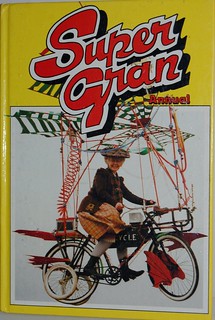 Meanwhile, he was still writing comics, back where we left him in the mid-seventies, but now from the comfort of his own home, which is where he worked from from then on. He had worked with comics’ editor Dez Skinn in his time at Odhams/IPC/Fleetway (where there had been many mergers, and name changes, both of the comics and the companies producing them), and went on to work with him in a number of titles for other companies, including House of Hammer (1976), Starburst (1977), Hulk Comic (1979), and Dr Who Weekly (1979). He also ended up writing some, most, or all of the contents of TV and movie tie-in annuals for John Barraclough at Brown, Watson/Grandreams Ltd, starting with the Kung Fu Annual in 1974, and going on to write a total of 69 over the course of the next thirteen years. An average year – 1979, in this instance – saw him write content for the Dick Turpin, Fantastic Four, Hulk, Sherlock Homes & Dr Watson, Spider-Man, Star Trek – The Motion Picture, and Young Maverick annuals. One year he wrote a Supergran annual. If you’re from this side of the Atlantic, and in a certain age range, there’s a very good chance you got annuals he wrote for Christmas. As well as all of this, he worked a few days a week at Dark They Were and Golden Eyed, wrote for the Fortean Times, and even wrote for ‘men’s’ magazines, including a story for Titbits that was allegedly a true telling of My Sexual Adventures in Bangkok, but was obviously entirely fictional, as he had never been farther east than Dover. This story was to have been published under the newly-devised pseudonym of Pedro Henry, although some sort of editorial gremlin saw it actually go out under his own name, embarrassingly. But Pedro would survive to fight another day.
Meanwhile, he was still writing comics, back where we left him in the mid-seventies, but now from the comfort of his own home, which is where he worked from from then on. He had worked with comics’ editor Dez Skinn in his time at Odhams/IPC/Fleetway (where there had been many mergers, and name changes, both of the comics and the companies producing them), and went on to work with him in a number of titles for other companies, including House of Hammer (1976), Starburst (1977), Hulk Comic (1979), and Dr Who Weekly (1979). He also ended up writing some, most, or all of the contents of TV and movie tie-in annuals for John Barraclough at Brown, Watson/Grandreams Ltd, starting with the Kung Fu Annual in 1974, and going on to write a total of 69 over the course of the next thirteen years. An average year – 1979, in this instance – saw him write content for the Dick Turpin, Fantastic Four, Hulk, Sherlock Homes & Dr Watson, Spider-Man, Star Trek – The Motion Picture, and Young Maverick annuals. One year he wrote a Supergran annual. If you’re from this side of the Atlantic, and in a certain age range, there’s a very good chance you got annuals he wrote for Christmas. As well as all of this, he worked a few days a week at Dark They Were and Golden Eyed, wrote for the Fortean Times, and even wrote for ‘men’s’ magazines, including a story for Titbits that was allegedly a true telling of My Sexual Adventures in Bangkok, but was obviously entirely fictional, as he had never been farther east than Dover. This story was to have been published under the newly-devised pseudonym of Pedro Henry, although some sort of editorial gremlin saw it actually go out under his own name, embarrassingly. But Pedro would survive to fight another day.
While all this was going on, there were changes afoot in British comics. In February 1977 IPC Magazines launched 2000 AD, one of the tiny handful of UK comics that is still in print. Steve Moore’s first story for 2000 AD appeared in Prog 12 (that is, issue #12), with the first part of a 12-part Dan Dare story, on the14th of May, 1977. He would continue to write for the comic, on and off, for nearly thirty years, finishing with Prog 1458 on the 28th of September, 2005. In Prog 25, he wrote the very first story to be called a Tharg’s Future Shocks, which would become an umbrella title for very short stories – which is still used as try-outs for new talent – which would go on to be written by all sorts of people, like Neil Gaiman, Peter Milligan, and Alan Moore.
Alan Moore, who is famously no relation to Steve Moore, had first met his namesake through the pages of Phil Clarke’s sales-list fanzine The Comic Fan, around the middle of 1967, where Steve had advertised looking for a book called Dead or Alive, an Avengers novelisation – the British TV series Avengers, rather than the American comic Avengers, that is. In the end, it turned out that the book had never actually been published, of which Steve Moore said,
So the whole friendship is basically rooted in a quest for a non-existent, chimaerical book … which is a motif that’s turned up occasionally in the work of one or other of us, in mine as recently as Somnium. It’s not a bad symbol for writers, too, as their job is to bring non-existent books into existence, by writing them. But perhaps more interestingly, in view of our more recent notions about Idea Space, we were brought together by the idea of a text, rather than a real one. Attribute whatever significance you wish to that. Maybe it was just the universe having a laugh.
A regular correspondence soon developed between the fourteen-year-old Alan and the eighteen-year-old Steve, and Alan would become one of Steve’s two closest friends, along with Bob Rickard. And Steve is the man Alan blames for leading him astray, in all sorts of ways, although Steve begged to differ, when I asked him about it…
PÓM: I have this romantic scenario in my head where Alan is the wild one, always leading you astray, whilst you are the quiet one, being dragged into all sorts of wild scrapes by your friend. But this is really entirely wrong, isn’t it, as regards comics, drugs, and magic? You are quite literally the man who led Alan Moore astray.
SM: Well, I’d like to portray myself as an evil Svengali who took one look at Alan and realised that here was a striking-looking but malleable individual who I could get years of pleasure destroying an inch at a time, but it wasn’t really like that … even if he has said publicly that I was the man who ruined his life! I just wander into these things like writing comics, smoking dope, practicing magic and resigning on points of principle, and the next thing I know Alan’s decided that as I haven’t actually died as a result, he’ll do the same … only he does it much larger. It’s not my fault, honest! Mind you, he doesn’t always follow my lead. I’ve never got him hooked on China or classical music, in the same way that I’ve never really shared his interest in science or stand-up comedy. We just have areas of interest that overlap … and enormous mutual respect in areas where they don’t. And even where they don’t, there’s still a bit of influence going back and forth.
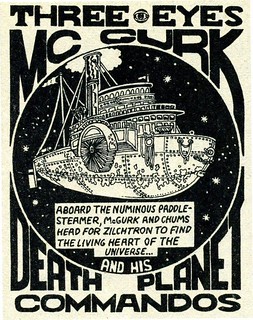 Both Moores were interested in working in comics, and would later quite often try to put work each other’s way. Alan was perfectly capable of getting his own work into music paper Sounds in 1979 – where Steve would later take over writing scripts for Alan to draw on the younger Moore’s The Stars My Degradation comic strip – and into 2000 AD, where he would write Future Shocks. Steve, meanwhile, had a hand in the early planning of a new comics magazine in the early eighties called Warrior, where actual rights for creators were promised by the publisher, Dez Skinn, and suggested that his friend Alan might be able to help relaunch 1960s UK superhero Marvelman for the title. Between the two Moores, they did the vast majority of the writing for Warrior, with the senior contributing strips including The Legend of Prester John, Father Shandor, Demon Stalker, and Laser Eraser and Pressbutton. Later on there would be Twilight World, and the wonderful Zirk stories, and lots of other bits and pieces, some under his revived pseudonym of Pedro Henry. This eventually led to both Moores writing comics for the American market, with Steve’s Laser Eraser and Pressbutton appearing in Eclipse Comics’ Axel Pressbutton series.
Both Moores were interested in working in comics, and would later quite often try to put work each other’s way. Alan was perfectly capable of getting his own work into music paper Sounds in 1979 – where Steve would later take over writing scripts for Alan to draw on the younger Moore’s The Stars My Degradation comic strip – and into 2000 AD, where he would write Future Shocks. Steve, meanwhile, had a hand in the early planning of a new comics magazine in the early eighties called Warrior, where actual rights for creators were promised by the publisher, Dez Skinn, and suggested that his friend Alan might be able to help relaunch 1960s UK superhero Marvelman for the title. Between the two Moores, they did the vast majority of the writing for Warrior, with the senior contributing strips including The Legend of Prester John, Father Shandor, Demon Stalker, and Laser Eraser and Pressbutton. Later on there would be Twilight World, and the wonderful Zirk stories, and lots of other bits and pieces, some under his revived pseudonym of Pedro Henry. This eventually led to both Moores writing comics for the American market, with Steve’s Laser Eraser and Pressbutton appearing in Eclipse Comics’ Axel Pressbutton series.
He also contributed occasionally to another ambitious British comics anthology series, Atomeka Press’s A1, including an article about Fortean Times in A1 #2, in January 1990, which I read, and which caused me to go looking for the magazine, and which, along with Jan Harold Brunvand’s The Vanishing Hitchhiker, was responsible for fundamentally changed my worldview. In is no exaggeration to say that a good deal of what I am today has been shaped by my reading that article in A1 #2, and by Steve Moore.
But he soon moved away from comics, mostly, and this was when he was heavily involved with Fortean Times, as mentioned above. He did come back to comics, to write for Alan Moore’s America’s Best Comics imprint, where he contributed to titles like Tom Strong, Tom Strong’s Terrific Tales, and America’s Best Comics: A to Z. His last work for comics was to write two five-issue mini-series for Radical Comics, Hercules: The Thracian Wars and Hercules: The Knives of Kush, on which the forthcoming film, Hercules: The Thracian Wars, is based.
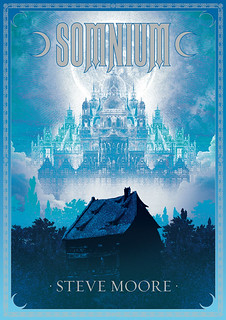 By the middle of the new millennium, though, he was done with comics, and had retired, largely to look after his brother Chris, who was suffering from Motor Neuron Disease. Chris Moore died in 2009, after a remarkable life of his own, in his own chosen field – as documented in this eulogy by Alan Moore – and his brother Steve found himself with time to write his first novel, Somnium: A Fantastic Romance. This was published by Strange Attractor Press, in association with his own Somnium Press, in November 2011, and this is the point at which my own occasional interactions with Steve Moore were to stop being virtual, and become real.
By the middle of the new millennium, though, he was done with comics, and had retired, largely to look after his brother Chris, who was suffering from Motor Neuron Disease. Chris Moore died in 2009, after a remarkable life of his own, in his own chosen field – as documented in this eulogy by Alan Moore – and his brother Steve found himself with time to write his first novel, Somnium: A Fantastic Romance. This was published by Strange Attractor Press, in association with his own Somnium Press, in November 2011, and this is the point at which my own occasional interactions with Steve Moore were to stop being virtual, and become real.
I got offered a review copy of the book – probably prompted by my writing this piece about the book – and, out of the blue, also got an email from Steve Moore, thanking me for the piece, and asking if I would like to ask him any questions about it. After I got over my genuine shock at getting a mail from a man I had always presumed was going to be forever beyond even my reach, I told him that I would indeed. And I did, ending up with this interview, which went online on the 11th of November, 2011, as pleasing and magical a date as you could wish for.
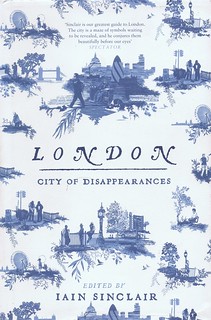 There was one other aspect of Steve’s life that he cared about deeply, and shared with his friend Alan: Magic. This was, once again, a field where the older Moore had taken the lead, although the younger one is the more famous of the two of them for doing it. Both of them had their own chosen deity: The moon goddess Selene in Steve’s case, and the snake god Glycon in Alan’s. Together, they formed The Moon and Serpent Grand Egyptian Theatre of Marvels, originally a two-man coven – but soon to include many of their friends also – for which they laid out the ground rules in Kaos #14 in July 2002, as republished by myself on my own Glycon blog. Despite their flippant words there, it was something they both took seriously. One of its outgrowths would be Alan Moore’s Unearthing, a 45-page essay for the Iain Sinclair edited London: City of Disappearances, which I asked him about when I interviewed him in 2011:
There was one other aspect of Steve’s life that he cared about deeply, and shared with his friend Alan: Magic. This was, once again, a field where the older Moore had taken the lead, although the younger one is the more famous of the two of them for doing it. Both of them had their own chosen deity: The moon goddess Selene in Steve’s case, and the snake god Glycon in Alan’s. Together, they formed The Moon and Serpent Grand Egyptian Theatre of Marvels, originally a two-man coven – but soon to include many of their friends also – for which they laid out the ground rules in Kaos #14 in July 2002, as republished by myself on my own Glycon blog. Despite their flippant words there, it was something they both took seriously. One of its outgrowths would be Alan Moore’s Unearthing, a 45-page essay for the Iain Sinclair edited London: City of Disappearances, which I asked him about when I interviewed him in 2011:
PÓM: You are legendarily reclusive. How did you feel about Alan’s Unearthing, which is essentially a tell-all biography of you? Or is the reputation for reclusiveness exaggerated?
SM: Reclusiveness is relative! I prefer to think of myself more as ‘private’. I love seeing my friends, and I like going out (though with the state of 21st century culture, it has to be said that there isn’t really a great deal to go out for, except perhaps dinner) … but I just don’t like making public appearances, and I’m not at all interested in fame or reputation. All I want to do is write. I don’t have the slightest interest in the game of being ‘a famous writer’ and I’ve no liking for Conventions, so nobody sees very much of me. Which suits me …
Anyway, as for Unearthing … Alan was invited to contribute a piece to Iain Sinclair’s anthology London: City of Disappearances, and really the only part of London he knew anything about was Shooters Hill, as he kept visiting me here. He then decided, for reasons best known to himself, that he wanted to make it a biography of me as well, so I just said okay. I told him I’d correct any factual details, which I did, but apart from that he could write anything he liked about me, which is what he did! Apart from the comic exaggeration in places, it’s all true, so I said fine and thought the piece would disappear as one of Alan’s ‘minor works’. Obviously it didn’t happen like that! Now it’s become an audio-recording, been performed, will soon appear as a coffee-table book photo-illustrated by the brilliant photographer Mitch Jenkins and, apparently, will even be coming out as an app. How do I feel about all this? Well, I imagine that like most people I tend to judge what’s ‘normal behaviour’ pretty much against what I do myself, so I’m just sort of bewildered by all the attention it’s getting. But overall, it’s been a lot of fun hanging out with Mitch and his photographic team, meeting the musicians and attending the performances. And the whole thing has rather surprised my friends and relatives!
PÓM: I suppose there’s an enormous irony in a piece about a private man becoming the subject of such an amount of attention, particularly in a book apparently about disappearing. There’s a section in Unearthing where Alan dictates what happens next, and then has you do what he’s said you would. Did this actually happen, or is that just Alan entertaining himself?
SM: Of course it happened! I read through the manuscript when it first arrived and knew I just had to go for my usual walk, as described. And, yes, I hung about for a while by the burial mound, as described, and there were actually rain showers that morning. Unfortunately I couldn’t quite disappear, as the manuscript prescribed! But you have to remember that Unearthing was both about magic and, to a certain extent, was a magical piece in itself, with the writing and world described merging together. So I naturally acted out what was described, just to ‘make that real’. And Alan knew I would when he wrote it, even though he hadn’t told me in advance what he was intending to do.
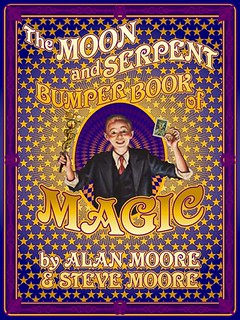 Although Steve Moore had essentially retired from work, having passed 60 in 2009, he did still have a few projects that he kept up with. He had a wide correspondence, and kept up his Fortean-related activities. He had been, for quite a number of years, slowly working with Alan Moore on a book called The Moon and Serpent Bumper Book of Magic, a project that was finally actually approaching an end. Under his own Somnium Press imprint, he produced occasional 16- or 20-page booklets, mostly composed of his own Tales of Telguuth, which he had at one stage also written for publication in illustrated comics for in 2000 AD.
Although Steve Moore had essentially retired from work, having passed 60 in 2009, he did still have a few projects that he kept up with. He had a wide correspondence, and kept up his Fortean-related activities. He had been, for quite a number of years, slowly working with Alan Moore on a book called The Moon and Serpent Bumper Book of Magic, a project that was finally actually approaching an end. Under his own Somnium Press imprint, he produced occasional 16- or 20-page booklets, mostly composed of his own Tales of Telguuth, which he had at one stage also written for publication in illustrated comics for in 2000 AD.
And, in August 2013, out of the blue, once again, I got an email from him saying,
I’m not quite sure why, but in the last few days I remembered that when we were last in touch you expressed an interest in doing a more general interview with me, and now that I’ve got a bit of distance from the comics industry, I thought it might be time for a retrospective. It’s something I’ve put off, although I’ve never really had a problem with interviews on more specific subjects, like Abslom Daak or Somnium … but I’ve always tended to be a bit nervous about more general retrospectives, because I want to avoid situations where I’m asked questions like ‘You know Alan Moore better than anyone, so tell us all about him and … etc.’ That’s still not an area I particularly want to get into, but if you want to discuss my life and career, I’d probably be up for that. Assuming you’re still interested, of course …
So if you’re up for it, I’d probably prefer to do this by email, as I then get time to think about my answers, and possibly look things up (though a lot of records have long disappeared … along with large chunks of my memory!), but we can always do further sets of questions if you want to ask me more about something that’s come up. And as it’s a pretty long career, we might want to do it in sections, too. But if we both look on it as ‘something we do when we have time, around other things’, I imagine we could do it. Let me know what you think. No obligation, of course. If you’ve got better things to do, no problem!
So, did I want to interview the most reclusive man in British comics, and a man who had, unknown to himself, taken a hand in my own life, here and there? Yes, I most certainly did. We started a slow to-and-fro correspondence, working through his life from its beginnings in 1949, slowly towards the present day. I’d send a handful of questions, he’d send answers back, and I would then respond with additional questions about his answers, as well as some fresh questions to move it all forward a little, and so on. It slowly inched onward, not only at the cutting edge of it, but in the middle as well, as either he or I thought of something that might be useful to add in to a particular section. Sometimes he would suggest specific questions, and sometimes I would suggest how I wanted him to answer a particular question, to allow us to reach a particular thing we wished to discuss. It was probably the most satisfying interview process I had taken part in, of all the interviews I have done.
Amongst other things, behind the veil of private emails, we discussed our own lives, a little. We both were unwell, in our own ways. I had prostate cancer, but it was going to take years to get me. He had problems with his stomach and lungs, and was having regular CT scans, but as recently as the beginning of February he had been told it was all under control, and that he needn’t bother coming back for another scan until October. There was certainly no sense of imminent death, and I had imagined that another few months would get us to the end of the chronological part of the interview, and onto more etheric matters, like his ideas about writing, and about magic, and other things. Then a bit of editing, and we would actually have a usable document, although exactly what would happen to it, and how or where it would actually be published, was still anyone’s guess.
I had broached the idea of death with him, early on, and had intended to come back to it towards the end of the interview.
PÓM: I can’t help noticing that both of your parents and your brother died in their sixties. Does this give you pause for thought at all, seeing as you’re in your sixties yourself now?
SM: Yes, of course it does, especially now that I’m developing a few common medical problems associated with ageing. On the other hand, though, my maternal grandfather lived to be 90, so there may be hope for me yet! But I’m pretty much of a fatalist, and a recent scientific notion about the nature of time (called ‘Eternalism’) suggests the future already exists and the universe may actually be deterministic. A lot of people don’t like that idea, but I actually find it rather comforting, because it means that everything happens in the only way it possibly can, whether we like it or not. Even if that’s not the case, when it comes to time to go, I’ll just have to go, so there’s not really any point in fretting about it. But I’m aware that my time isn’t limitless, and some projects can’t be left forever. And that awareness may also have had something to do with my deciding to do this interview.
In the meantime we both took holidays, had problems with our computers, and got distracted by other things, as one does. By the beginning of March, six months after we started, and after a little over 48,000 words, we had got as far as Warrior – already the size of a small book, with the prospect of possibly the same amount again to come. I had sent off a last handful of questions, just to tidy up the very end of what I needed to know about his time at Warrior. When I didn’t hear back from him after a week or so, I sent another, and then sent a mail to a few other people, to see if they had heard from him. They hadn’t. One of them arranged to have a member of the police call to the house on the evening of Tuesday the 18th of March, and he was found dead there. There hasn’t been an official announcement of the cause of death, but it’s likely that it’ll turn out to be related to his heart, or his lung problems, I imagine.
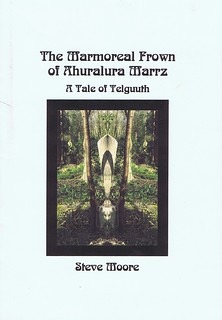 One of the last things we know Steve Moore did was to post out copies of The Marmoreal Frown of Ahuralura Marrz, his last Somnium Press booklet, and a copy arrived to me on Wednesday morning, which I got just a few short hours after hearing of his death. It’s hard not to think of it as a last magical act, a last story from a great man, and a great storyteller, set to arrive after his death. As he said himself, in another context, ’Attribute whatever significance you wish to that. Maybe it was just the universe having a laugh.’
One of the last things we know Steve Moore did was to post out copies of The Marmoreal Frown of Ahuralura Marrz, his last Somnium Press booklet, and a copy arrived to me on Wednesday morning, which I got just a few short hours after hearing of his death. It’s hard not to think of it as a last magical act, a last story from a great man, and a great storyteller, set to arrive after his death. As he said himself, in another context, ’Attribute whatever significance you wish to that. Maybe it was just the universe having a laugh.’
I only got to meet Steve Moore once, in London last November, when he surprised not least himself by going along to An Evening with Alan Moore, to mark the launch of Lance Parkin’s biography of the younger Moore. There were many things about the evening I treasure, and meeting Steve is very high on that list. I had fully imagined that we would meet again, on one of my occasional visits to London, but that is no longer to be. And I still can’t really believe that.
He had already made plans for his funeral – in Sketches of Shooters Hill, another of his Somnium Press booklets, whilst talking about a four-thousand year old Bronze Age burial mound on Shooters Hill, he says,
Born high up on Shooters Hill myself, when I die I want my ashes scattered on the burial mound, by the light of a lovely full Moon. So, just for a moment, I too can become an offering to the local Gods and Goddesses, and merge my essence with the native soil … before all that physically remains of me is blown away and scattered, like oak-leaves on the whirling wind.
I hope I can be there, at least for that, to pay my final respects to a wonderful, extraordinary, and gentle man.

[The first and last photos are by Kevin Storm, and are used with his permission. The rest are a mixture of images Steve Moore sent me, to go along with the interview we were doing, scans of my own books, and things I've, essentially, robbed off the internet. ]
– Pádraig Ó Méalóid –

The Gwar frontman is dead at age 50. Gwar had a big comics crossover of inspiration and I know they played Comic-Con several times.
Photo via Diabolique Magazine
I hate that this sentence
must now be in the past tense:
Lucius Shepard was one of the great American writers.
It's hard to find words, even though I've had 24 hours to search.
In
a review of The Dragon Griaule, I invoked Conrad and melodrama, and quoted
Eric Bentley on both. Here's part of that quote again, because it gets at exactly what Lucius Shepard's stories mean to me, and why they mean so much:
Only under the influence of a narrow and philistine Naturalism can we ask why an artist shows life at a remove and in some established genre. The transposition of an inner struggle to a duel between persons does not even need a convention to carry it: such changes are made nightly by everyone in his dreams. If one can make of one's tussels with suicidal wishes a drama of love and honor, one has given to private and chaotic material a public and recognizable form. One has made art out of fantasy and pain.
And now a sentence from the introduction to the final collection of stories published during Lucius Shepard's lifetime,
Five Autobiographies and a Fiction, after a description of a harrowing childhood and adolescence:
For the next twenty years I traveled aimlessly, engaged in bar fights, street fights, insulated myself from the possibility of self-examination with drugs, played in a number of rock bands, married twice without giving the matter much thought, dabbled in low-level criminality, drug-dealing, burglary, etc., and escewed anything that smacked remotely of the cerebral.
Luckily, he found his way out of at least some of that darkness, those difficult decades. He attended the Clarion writers' workshop and a few years later his stories began to appear in magazines and anthologies, and his first novel,
Green Eyes, was published as part of the resurrected
Ace Specials line that also brought out
Neuromancer and Kim Stanley Robinson's first novel,
The Wild Shore, among others.
I could try to be objective here and talk about the specific qualities of Lucius Shepard's writing that set him apart from most of his peers for me — the long, languorous sentences, of course; the precision of the imagery; the complexity of form; the rich social world implied from the texts; the fascination with the perils of machismo; the great variety of types of stories unified not by genre but by vision and even, to use a rather antiquated term, moral conviction; the sheer imaginative force the best of the work displays.
Maybe another time. It feels too cold and academic. Too un-Lucius. He hated analysis that got away from the practical. His entertainingly curmudgeonly
movie reviews were always based in a very personal voice, producing the sense of somebody talking to you from his own experience, hoping maybe that his experience could connect with, enlighten, enliven, enrage your own. I'm not (yet) interested in being entertainingly curmudgeonly, but I can't speak of Lucius Shepard right now without speaking about what, and how, his work meant to me.
(A momentary, weird personal aside: The indefatigable researchers at the Science Fiction Encylopedia
are confident that Lucius Shepard was born in 1943, not 1947 as he often claimed. If so, that means he was one day younger than my father.)
I started reading Lucius's stories when I started reading science fiction. My mother's boss subscribed to
Asimov's and loaned me a few issues. That first batch included the
April 1986 issue. The cover story was "R&R".
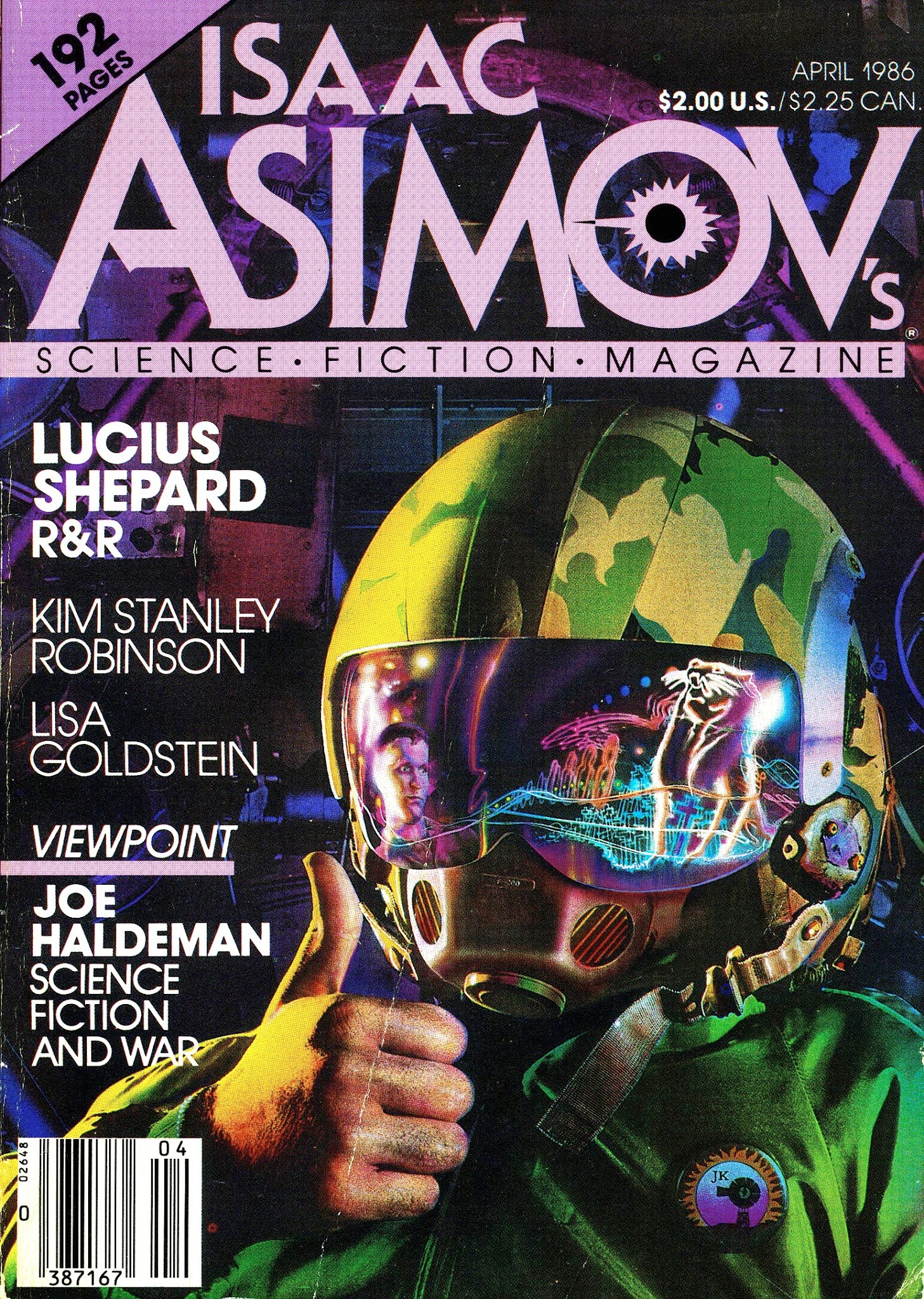 |
| cover illustration by J.K. Potter |
I don't think I read all of "R&R" then — I was too young, it was too dense — but I gave it a good shot. I was, after all, just getting over my infatuation with
G.I. Joe and
Rambo, and so J.K. Potter's cover and interior illustrations for the story grabbed my interest immediately. (That cover is seared into my brain.) I did start reading Shepard pretty soon, though, because once I was a confirmed sci-fi nerd, my parents let me join the Science Fiction Book Club, and one of the first books I got was Gardner Dozois's
Year's Best Science Fiction: 3rd Annual Collection, which included two Lucius Shepard stories,
"The Jaguar Hunter" (the first story in the book) and "A Spanish Lesson". I wanted to know what "good" science fiction was, and the presence of two stories meant this was a major writer, so I studied those stories intensively. I don't remember what I made of them. I think I thought they were slow, but there was something alluring in them, something that wouldn't let go of me (and that never let go of me).
A few years later, I got a paperback copy of
The Jaguar Hunter, which collected most of the best of those early stories (the paperback omitted "R&R", which had been incorporated into
Life During Wartime, a book I picked up, but to this day have never completely read because some genius at Bantam Spectra decided the whole nearly-500-page book ought to be in san serif font. It's ghastly!). By that time I was in my mid-teens, had become a better reader, and followed Shepard's career closely. "The Man Who Painted the Dragon Griaule" and "The Scalehunter's Beautiful Daughter" were particular favorites from the early years, but many of the novellas of the 1990s also wowed me and wooed me, bringing me back to science fiction magazines even when I had claimed to move on to better things. The stories were vivid and gnarled, unpredictable, sometimes vexing in their ambiguities, their complex dance with the conventions of narrative form. They clung and haunted. "Skull City", "Barnacle Bill the Spacer", "Beast of the Heartland", "Radiant Green Star" — I still have the magazines and still remember where I was sitting when I read each story.
It was in the new century, though, that Lucius Shepard got really, really good. His work deepened, darkened, thickened. In addition to
The Dragon Griaule and
Five Autobiographies and a Fiction, read
Viator. Read
A Handbook for American Prayer. Read
Floater. Read
Eternity and Other Stories, which includes
"Only Partly Here", still one of the most powerful stories I've ever read about 9/11
. (If you need a primer, Subterranean Press is offering
the e-book of The Best of Lucius Shepard for $2.99 at the moment.)
I got to know Lucius a little bit in his last years, mostly via Facebook, oddly enough — it proved to be a pretty good forum for him. I first met him in 2007 when we were the two readers at the
KGB Fantastic Fiction series for that November. It felt bizarre to be reading on the same bill as Lucius. I think I was there because there wasn't really anybody else around who was willing to do a reading a couple days before Thanksgiving. Or something. I don't know. I certainly didn't
deserve to be on a bill with Lucius Shepard! (Even I just wanted me to hurry up and finish my reading so Lucius could begin!) I was terribly intimidated and terrified of him, even though he was gracious and friendly. But he was
Lucius Shepard — one of the greats! I wish I'd had more guts that night, wish I'd chatted with him more, wish I'd gotten him to sign a book. But I was too nervous. We talked a bit at dinner afterward, and then later on we corresponded some. Just as I felt like I was getting to know him, he began to have his most serious health problems, including a stroke. I had plenty of faith that he'd pull out of it, that he'd write again. He had to. How could the world not have the force of his words?
I keep thinking back to a moment of childhood: visiting the Avenue Victor Hugo Bookshop in Boston in the late '80s and paging through the
Arkham House hardcover of
The Jaguar Hunter, which I couldn't afford to buy. $21.95 was a fortune to me then. I looked at the book and looked at it and looked at it. But that's not why I keep thinking about it. What I keep thinking about is this: A year or two ago, I got a pristine copy of that book for pennies. A price I could have afforded even when I was a kid. A first edition, first printing of a brilliant book that ought to be a collector's item selling for a hundred times what I paid for it. I was happy to get a gift for my inner child, but also deeply angry that I could afford it — that it's
not as valuable and scarce as it deserves to be just reminds me of how little valued Lucius's work is in comparison to its quality.
He should have been a literary star. He should have been recognized as one of the great writers of his generation. Because he was. Sure, sometimes his need for money caused him to sell work that wasn't entirely great, but he should be judged by his best, which is as good as the work of nearly any of his contemporaries (not just in the science fiction field; his work is richer, more powerful, more vivid, more weird, and more meaningful than that of all but a couple of his contemporaries in SF, but it also makes most of the fiction written in any genre or non-genre look unambitious, minor) — and there's a lot of best. (And even the less-than-best is usually quite wonderful for a few pages at least.) His work probably doesn't have the qualities of bestsellerdom, but it should have been — should be — recognized more fully, appreciated more deeply. He won nearly every award in the SF field at least once, but I don't think it was enough, because he deserved a pile of the damn things. He deserved other awards, too, not just genre ones. But even within the genre that he ended up (imprisoned?) in, he wasn't as well known as he should have been, nor was his accomplishment recognized as fully as it deserved. The same could be said for plenty of people, yes, but I've felt for a long time that it's especially unjust in Lucius's case, because the work is so varied, so powerful, so special.
So here we are, then, in a world without Lucius. We've got the words, though, the pages and the books — and we ought to do something with them — we ought to seek them out and get more of them back into print, we ought to harangue critics to write about Lucius's work with the depth and seriousness it deserves — and, too, we ought to sing songs in his honor and spend a bit too much time in a bar now and then, we ought to howl at the moon, we ought to seek out some good movies, we ought to scowl at liars while recognizing what liars we are, we ought to stand up for the weak, we ought not ever get too settled in ourselves, we ought to write long sentences, we ought to be gracious, we ought to be angry, we ought to fight against borders and pigeonholes and easy expectations, we ought to stand brave against the violence at the heart of our selves, we ought to dream and laugh and spare some time for people different from us, we ought to seek to be more and better, to escape old pasts and old resentments and, most of all, old failures — because we're what's left, and we're still here, and the words still live.
We had reached a spot overlooking a strip of white beach guarded at both ends by enormous boulders. The blue sea stretched tranquil and vast to the horizon, and the cloudless sky, a lighter blue, empty of birds, echoed that tranquility. Nothing seemed to move, yet I felt a vibration in the earth and air that signaled the movement of all things, the flux of atoms and the drift of unknown spheres. An emotion swelled in my breast, nourished by that fundamental vista, and I felt, as I had not in years, capable of belief, of hope, of seeing beyond myself. Jane linked her arm through mine and rested her head against my shoulder, and whispered something that the wind bore away. And for that moment, for those minutes atop the hill, we were as happy as the unhappiness of the world permits.
—"Rose Street Attractors", the final story in Five Autobiographies and a Fiction by Lucius Shepard
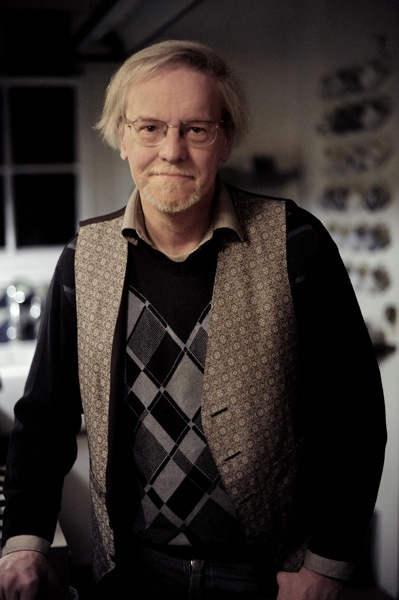
Via Strange Attractor Magazine comes word that writer Steve Moore has passed away at the age of 65. Moore was a prolific comics writer, as well as an early editor of and contributor to Fortean Times. Among his comics work, many series for 2000AD and Rebellion, including Lazer Erazer, Axel Pressbutton, Future Shocks, Red Fang and Valkyrie. Moore also wrote for Marvel UK and DC, but is best known for friendship and mentorship of the unrelated Alan Moore, who cited him as a huge influence.
Steve Moore worked on several Alan related projects including stories for Tom Strong’s Terrific Tales, the novelization of V for Vendetta and the yet to be published The Moon and Serpent Bumper Book of Magic, co-written by Alan.
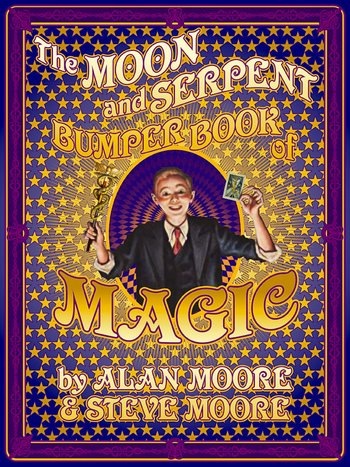
[photo by Etienne Gilfillan]
 Author Dr. Sherwin B. Nuland has passed away. He died of prostate cancer. He was 83 years old.
Author Dr. Sherwin B. Nuland has passed away. He died of prostate cancer. He was 83 years old.
Nuland was the author of How We Die, a nonfiction work about assisted suicide. The book won a National Book Award in 1994 and was a finalist for the Pulitzer Prize and the Book Critics Circle Award in 1995. He also wrote Doctors: The Biography of Medicine, Medicine: The Art of Healing, The Wisdom of the Body, and The Mysteries Within: A Surgeon Reflects on Medical Myths.
He regularly wrote a column on medicine and biomedical ethics called “The Uncertain Art,” for The American Scholar. He was also contributing editor to The American Scholar and The New Republic.
Nuland served as clinical professor of Surgery at the Yale School of Medicine, and as Chairman of the Board of Managers of the Journal of the History of Medicine and Allied Sciences. He was also a member of the editorial board of Perspectives in Biology and Medicine, and a member of the Bioethics Committee of Yale New Haven Hospital. (Via NPR Books).
New Career Opportunities Daily: The best jobs in media.
 Veteran comic book artist Nick Cardy has died. He was 93 years old.
Veteran comic book artist Nick Cardy has died. He was 93 years old.
Cardy was best known for his work with DC Comics and his work drawing Teen Titans and Aquaman. According to NickCardy.com, Cardy worked for the Iger/Eisner studio drawing for Fight Comics, Jungle Comics, Kaanga Comics for Fiction House. In the fifties he drew the Tarzan comic strip. When he started his career at DC Comics, he drew The Legends of Daniel Boone, a comic with only a couple of issues. In the 1970s he created artwork for movie posters including: Apocalypse Now, Movie, Movie and California Suite.
In 2005, Cardy was inducted into the Will Eisner Comic Book Hall of Fame. (Via Comicbook.com)
New Career Opportunities Daily: The best jobs in media.

Cuban American novelist Oscar Hijuelos has passed away. He was 62 years old.
He became the first Latino to win the Pulitzer Prize for fiction with The Mambo Kings Play Songs of Love in 1989. Hijuelos wrote eight novels and a memoir called Thoughts Without Cigarettes. In an interview about that memoir, the novelist reflected on his early inspiration as a kid growing up in New York City:
I don’t think the New York of my youth did a “better job” of fostering creativity, which comes from within and not from without, but it did offer the average kid a much broader range of choices in terms of affordable and inspiring activities; just about everything was much cheaper. And there were a greater range of interesting mom-and-pop shops to enjoy: For example, I miss the old second-hand bookstores that one could find on Fourth Avenue and getting lost in that world. Surely you can find the same stuff these days on the Internet, but it’s just not as much fun. I can remember how one could walk into the Pierpont Morgan Library for free—now it’s about twenty dollars—and the Metropolitan Museum of Art for a buck or two, or see a Broadway show for ten bucks.
New Career Opportunities Daily: The best jobs in media.
 Bestselling novelist Tom Clancy has passed away, ending a legendary career in espionage fiction.
Bestselling novelist Tom Clancy has passed away, ending a legendary career in espionage fiction.
Three of his books were turned into movies: The Hunt for Red October, Patriot Games, and The Sum of All Fears. His work was adapted into a number of video game franchises, including: Rainbow Six, Ghost Recon and Splinter Cell. CNN had the sad news:
[Clancy] died on Tuesday in a hospital in Baltimore. He was 66. The author Tom Clancy in 1996. Ivan Held, the president of G. P. Putnam’s Sons, his publisher, did not provide a cause of death.
New Career Opportunities Daily: The best jobs in media.

UK crime novelist Robert Barnard has passed away. He was 76-years-old.
Throughout the course of his career, Barnard (pictured, via) wrote 40 books and earned eight Edgar Award nominations. He enjoyed a following both in his native Great Britain and the United States. Here’s more from the New York Times:
Mr. Barnard called his work ‘entertainment’ and ‘deliberately old-fashioned.’ His murders, set mainly in small villages drolly christened with names like ‘Hexton-on-Weir’ and ‘Twytching,’ were plotted with an ingenuity and precision that made him popular among aficionados of what is known in publishing as the English cozy — mysteries with a picturesque setting, colorful locals and minimal violence. Reviewers said that many of his books crossed into the comedy-of-manners genre.
New Career Opportunities Daily: The best jobs in media.

Author and Writer Beware co-founder Ann Crispin has passed away.
Making Light posted the sad news and novelist John Scalzi shared a tribute to the science fiction writer. Earlier this week, she posted a final message for readers and writers on Facebook:
I want you all to know that I am receiving excellent care and am surrounded by family and friends. I wish all aspiring writers the will to finish and a good contract. Please continue to monitor Writer Beware and be careful who you sign with. Victoria Strauss and Richard White are there to help.
continued…
New Career Opportunities Daily: The best jobs in media.
 Hachette Book Group sales rep and bookseller Conan Gorenstein passed away this week. He was 64 years old.
Hachette Book Group sales rep and bookseller Conan Gorenstein passed away this week. He was 64 years old.
Gorenstein joined the publisher in 1991, working New York State, Vermont, Northeastern Pennsylvania and Connecticut. The publisher offered this tribute:
In his 22 years of service, Conan was a passionate sales rep, always interested in doing the best for HBG and his accounts Additionally, Conan was known far & wide for his cooking and kitchen experimentation – many accounts, authors & colleagues were delighted with his never-ending supply of baked goods … As many of us knew, Conan was a lover & aficionado of Magic, as his membership in the International Brotherhood of Magicians can attest to.
New Career Opportunities Daily: The best jobs in media.
 Author E.L. Konigsburg has passed away. She wrote the beloved kid’s book, From the Mixed-up Files of Mrs. Basil E. Frankweiler.
Author E.L. Konigsburg has passed away. She wrote the beloved kid’s book, From the Mixed-up Files of Mrs. Basil E. Frankweiler.
Her bookshelf also included A Proud Taste for Scarlet and Miniver and The View From Saturday. In an interview, she once said “You have to experience kindness in order to be kind,” explaining why she believed in practicing random acts of kindness. She also outlined her writing career:
I was the first one in my family to go away to college. I came from a small town where there was no guidance in the high school at all. It was a mill town, and I never knew anyone who made their living from the arts. When you did go away to college, you went away to be something – an engineer, or a teacher, or a chemist. I never knew anyone who went away to be an artist until I was in college. When I was in college at Carnegie Mellon, I wanted to be a chemist. So I became one. I worked in a laboratory and went to graduate school at the University of Pittsburgh. Then I taught science at a private girls school. I had three children and waited until all three were in school before I started writing. When my third child went away to school, I started to write in the mornings. I’ve already mentioned that I want to write something that reflects their growing up, because when I was growing up the books I read never reflected me.
New Career Opportunities Daily: The best jobs in media.
 Author A.S.A. Harrison has passed away.
Author A.S.A. Harrison has passed away.
Her debut novel, The Silent Wife, will be released in July. She also published Orgasms with Coach House Press, Revelations (co-written with Margaret Dragu) with Nightwood Editions and Zodicat Speaks with Viking Penguin.
Penguin shared a brief tribute: “We are deeply saddened over the loss of a great woman and a very gifted writer.” (Author photo via)
New Career Opportunities Daily: The best jobs in media.
View Next 25 Posts
 PÓM: You were involved in the first British comics conventions as well, I believe?
PÓM: You were involved in the first British comics conventions as well, I believe? I remember very little about that first convention (for many years I thought it had been in 1967!), though I recall the hotel as being big, old and gloomy. I think there may have been about 50 or 60 people there, and a few ‘non-attending’ members. There was the usual stuff: movies, panel discussions, auctions, but I only know this from looking at the bulletin, not from memory! It was all very small scale, and modelled on what we knew of SF conventions, but we had a good time and that was how it all started. I’m afraid I’m one of the guilty men …
I remember very little about that first convention (for many years I thought it had been in 1967!), though I recall the hotel as being big, old and gloomy. I think there may have been about 50 or 60 people there, and a few ‘non-attending’ members. There was the usual stuff: movies, panel discussions, auctions, but I only know this from looking at the bulletin, not from memory! It was all very small scale, and modelled on what we knew of SF conventions, but we had a good time and that was how it all started. I’m afraid I’m one of the guilty men …
 As I’ve said, I was mainly interested in getting new material together, rather than articles, and I don’t think I wrote much about comics, preferring to contribute stuff to magazines that fringed away from comics into fantasy and underground material, like John Muir’s Crucified Toad. A strange man who, I’m told, ended up in some sort of shady business in the East, and got himself murdered for it. Or so I’m told.<-
As I’ve said, I was mainly interested in getting new material together, rather than articles, and I don’t think I wrote much about comics, preferring to contribute stuff to magazines that fringed away from comics into fantasy and underground material, like John Muir’s Crucified Toad. A strange man who, I’m told, ended up in some sort of shady business in the East, and got himself murdered for it. Or so I’m told.<- SM: That’s right. If we backtrack to autumn 1966, I’d been stuck in the laboratory job for a year. So I decided to write letters to half a dozen comics publishers in London (yes, there were actually that many comics publishers in those days) and simply asked them if they had any jobs. I got polite replies (‘no’) from a couple of them, and one offer of an interview, from John Spencer & Co., the publishers of Badger Books, who at the time were publishing a couple of really bad black-and-white superhero books, which in the end only lasted a couple of issues each. So I made my way over to West London one evening to their tiny premises, which I think was pretty much one office and a storeroom, but it turned out they basically wanted a warehouseman, which really wasn’t what I was looking for. So I knuckled down to the flour samples and sulphuric acid fumes again.
SM: That’s right. If we backtrack to autumn 1966, I’d been stuck in the laboratory job for a year. So I decided to write letters to half a dozen comics publishers in London (yes, there were actually that many comics publishers in those days) and simply asked them if they had any jobs. I got polite replies (‘no’) from a couple of them, and one offer of an interview, from John Spencer & Co., the publishers of Badger Books, who at the time were publishing a couple of really bad black-and-white superhero books, which in the end only lasted a couple of issues each. So I made my way over to West London one evening to their tiny premises, which I think was pretty much one office and a storeroom, but it turned out they basically wanted a warehouseman, which really wasn’t what I was looking for. So I knuckled down to the flour samples and sulphuric acid fumes again. SM: Well, we were producing two titles a week, Pow! and Fantastic, so everything was on a pretty tight schedule. Ken Mennell was in overall charge and made the ‘strategic’ decisions, like which strips we’d run, in collaboration with managing editor Alf Wallace. I think Jane was mainly responsible for Fantastic, which, being mostly page-for-page reprints of Marvel Comics in black-and-white, with only one original strip (‘The Missing Link’, which later evolved into ‘Johnny Future’; written by Alf Wallace and drawn by Luis Bermejo), was a relatively simple, one-person job. Paul and I worked on Pow! which was a bit more complicated, being more a of traditional British comic apart from the ‘Spider-man’ reprint, which had to be resized to fit a British page format. It was mostly one or two page humour strips, with one or two original adventure strips, so that meant a lot to keep track of. We had a large-format ‘make-up book’, with two pages per issue and a sort of grid system on them, in which we’d write the dates that scripts arrived; when they were sent to the artist; when the artwork came back; when the pages were sent to the letterer (all hand-lettering in those days; no computer setting) and when they came back; and so on. Scripts had to be read and edited before they were sent out, and when the finished, lettered pages were in they had to be proofread and sent to the art department (the ‘bodgers’) for correction. I think we all proofread the pages to make sure nothing got through that shouldn’t be there, as the letterers were known to be occasionally mischievous … particularly John Aldrich, who seemed to take every possible opportunity to letter ‘public’ as ‘pubic’, and so on, just to see what he could get through … and Ken, as editor, certainly checked all the pages after we juniors had been through them. It was also drummed into us that we should never allow the use of the word ‘flick’ or the name ‘Clint’, which, when lettered in capitals were dangerously liable to turn into something quite unsuitable for a kid’s comic. Another maxim I learned very early on was ‘all printers are bloody idiots’, which meant their instructions had to be spelled out absolutely precisely, especially when it came to things like marking up the artwork with its reproduction size. Again, all this was pre-computers, so we were sending original artwork to the printer, and all the corrections had to be done by hand, rather than on screen. Obviously we also got proofs back from the printers that had to be checked through as well. ‘Editorial’ largely consists of reading stuff over and over again.
SM: Well, we were producing two titles a week, Pow! and Fantastic, so everything was on a pretty tight schedule. Ken Mennell was in overall charge and made the ‘strategic’ decisions, like which strips we’d run, in collaboration with managing editor Alf Wallace. I think Jane was mainly responsible for Fantastic, which, being mostly page-for-page reprints of Marvel Comics in black-and-white, with only one original strip (‘The Missing Link’, which later evolved into ‘Johnny Future’; written by Alf Wallace and drawn by Luis Bermejo), was a relatively simple, one-person job. Paul and I worked on Pow! which was a bit more complicated, being more a of traditional British comic apart from the ‘Spider-man’ reprint, which had to be resized to fit a British page format. It was mostly one or two page humour strips, with one or two original adventure strips, so that meant a lot to keep track of. We had a large-format ‘make-up book’, with two pages per issue and a sort of grid system on them, in which we’d write the dates that scripts arrived; when they were sent to the artist; when the artwork came back; when the pages were sent to the letterer (all hand-lettering in those days; no computer setting) and when they came back; and so on. Scripts had to be read and edited before they were sent out, and when the finished, lettered pages were in they had to be proofread and sent to the art department (the ‘bodgers’) for correction. I think we all proofread the pages to make sure nothing got through that shouldn’t be there, as the letterers were known to be occasionally mischievous … particularly John Aldrich, who seemed to take every possible opportunity to letter ‘public’ as ‘pubic’, and so on, just to see what he could get through … and Ken, as editor, certainly checked all the pages after we juniors had been through them. It was also drummed into us that we should never allow the use of the word ‘flick’ or the name ‘Clint’, which, when lettered in capitals were dangerously liable to turn into something quite unsuitable for a kid’s comic. Another maxim I learned very early on was ‘all printers are bloody idiots’, which meant their instructions had to be spelled out absolutely precisely, especially when it came to things like marking up the artwork with its reproduction size. Again, all this was pre-computers, so we were sending original artwork to the printer, and all the corrections had to be done by hand, rather than on screen. Obviously we also got proofs back from the printers that had to be checked through as well. ‘Editorial’ largely consists of reading stuff over and over again. SM: Basically it was Odhams’ attempt to model itself on Marvel Comics and included a fair amount of Marvel reprint. The titles involved were Wham! and Smash! , which were already established as more traditional British comics, but then started to include one or two Marvel reprints, with the American material
SM: Basically it was Odhams’ attempt to model itself on Marvel Comics and included a fair amount of Marvel reprint. The titles involved were Wham! and Smash! , which were already established as more traditional British comics, but then started to include one or two Marvel reprints, with the American material  SM: Eagle and Robin, which Odhams had taken over from their original publisher, Hulton Press, in 1959. Their companion papers, Swift and Girl had already folded by then. Eventually all the Power Comics titles started to suffer from declining sales, and merged with each other until there was only Smash! left. Then in 1969 Odhams and Fleetway were merged to become IPC Magazines, and that was pretty much the end of the line. For the last few months of Odhams’ independent existence we moved from Long Acre to offices in High Holborn, and then with the merger everything was transferred to Fleetway House in Farringdon Street.
SM: Eagle and Robin, which Odhams had taken over from their original publisher, Hulton Press, in 1959. Their companion papers, Swift and Girl had already folded by then. Eventually all the Power Comics titles started to suffer from declining sales, and merged with each other until there was only Smash! left. Then in 1969 Odhams and Fleetway were merged to become IPC Magazines, and that was pretty much the end of the line. For the last few months of Odhams’ independent existence we moved from Long Acre to offices in High Holborn, and then with the merger everything was transferred to Fleetway House in Farringdon Street. SM: The first story I sold professionally was a three-page ‘Pow Short Story’ called ‘The House in the Haunted Swamp’, that appeared in Pow! No. 45, late in 1967. It was drawn by a Turkish artist living in this country, called Ayhan Basuglu, and taught me a swift lesson, similar to the one about all printers being idiots … which was that you had to write for artists as if they were idiots as well, especially if English wasn’t their first language. It was set in a decaying house full of barrels of paraffin, and I’d told the artist to draw a guy exploring the place with a torch in his hand … meaning, of course, an electric flashlight. Mr. Basuglu promptly drew him with flaming torch, which wasn’t quite what I’d intended with all that paraffin around, so I had to do a bit of rewriting on the dialogue. By one of those weird symmetries, the same sort of thing happened on the last comic strip I wrote as well, Hercules: The Knives of Kush. On one issue they brought in a couple of Mexican artists to fill in, as Cris Bolson was getting behind schedule. My script asked for some characters wearing skullcaps, by which I meant close-fitting felt caps covering the cranium, and they drew a bunch of guys with actual skulls on their heads. Fortunately we managed to catch that at the pencil stage, so it wasn’t a problem, but with 40 years between the two events, you understand my feeling of déjà vu …
SM: The first story I sold professionally was a three-page ‘Pow Short Story’ called ‘The House in the Haunted Swamp’, that appeared in Pow! No. 45, late in 1967. It was drawn by a Turkish artist living in this country, called Ayhan Basuglu, and taught me a swift lesson, similar to the one about all printers being idiots … which was that you had to write for artists as if they were idiots as well, especially if English wasn’t their first language. It was set in a decaying house full of barrels of paraffin, and I’d told the artist to draw a guy exploring the place with a torch in his hand … meaning, of course, an electric flashlight. Mr. Basuglu promptly drew him with flaming torch, which wasn’t quite what I’d intended with all that paraffin around, so I had to do a bit of rewriting on the dialogue. By one of those weird symmetries, the same sort of thing happened on the last comic strip I wrote as well, Hercules: The Knives of Kush. On one issue they brought in a couple of Mexican artists to fill in, as Cris Bolson was getting behind schedule. My script asked for some characters wearing skullcaps, by which I meant close-fitting felt caps covering the cranium, and they drew a bunch of guys with actual skulls on their heads. Fortunately we managed to catch that at the pencil stage, so it wasn’t a problem, but with 40 years between the two events, you understand my feeling of déjà vu … As for creators, a lot of the humour strips were written by Walter Thorburn, who we’d lured away from D. C. Thomson, who were notorious for paying less than their London-based competitors. They’d also lured away Leo Baxendale, though I think he worked mainly for Wham! As for the adventure strips, I think Ken Mennell wrote mainly for Smash! … I’m fairly sure he wrote ‘Rubber Man’ ‘Bunsen’s Burner’ and ‘Cursitor Doom’ for them. Another string to his bow was coming up with plot outlines for thriller novels for the publisher W. Howard Baker, who had a stable of writers who’d then write them up. Ken would knock out the outlines in his lunch hours, at £30 a time, and I was obviously impressed by his productivity. Other adventure writers were Tom Tully and Scott Goodall, but I can’t remember which strips they were responsible for. As for humour artists, there was Mike Brown, who was very much a Leo Baxendale clone, and who I suspect may well be the artist on some material that’s been mistakenly identified as Baxendale. There was Mike Higgs, writing and drawing ‘The Cloak’, and the brilliant Ken Reid on ‘Dare-a-Day Davy’, who was actually a bit of a nightmare to work with, as he’d rewrite all the scripts he was sent, and we’d get back this lovely artwork with tiny pencilled dialogue in the balloons that was twice as long as would actually fit if lettered properly, so we had to cut it in half to make it work. There was Graham Allen and Terry Bave, who also wrote his own stuff. As for adventure artists, there were John Stokes and Eric Bradbury, though a fair number of stories were by Spanish artists, working through agencies like the Temple Art Agency.
As for creators, a lot of the humour strips were written by Walter Thorburn, who we’d lured away from D. C. Thomson, who were notorious for paying less than their London-based competitors. They’d also lured away Leo Baxendale, though I think he worked mainly for Wham! As for the adventure strips, I think Ken Mennell wrote mainly for Smash! … I’m fairly sure he wrote ‘Rubber Man’ ‘Bunsen’s Burner’ and ‘Cursitor Doom’ for them. Another string to his bow was coming up with plot outlines for thriller novels for the publisher W. Howard Baker, who had a stable of writers who’d then write them up. Ken would knock out the outlines in his lunch hours, at £30 a time, and I was obviously impressed by his productivity. Other adventure writers were Tom Tully and Scott Goodall, but I can’t remember which strips they were responsible for. As for humour artists, there was Mike Brown, who was very much a Leo Baxendale clone, and who I suspect may well be the artist on some material that’s been mistakenly identified as Baxendale. There was Mike Higgs, writing and drawing ‘The Cloak’, and the brilliant Ken Reid on ‘Dare-a-Day Davy’, who was actually a bit of a nightmare to work with, as he’d rewrite all the scripts he was sent, and we’d get back this lovely artwork with tiny pencilled dialogue in the balloons that was twice as long as would actually fit if lettered properly, so we had to cut it in half to make it work. There was Graham Allen and Terry Bave, who also wrote his own stuff. As for adventure artists, there were John Stokes and Eric Bradbury, though a fair number of stories were by Spanish artists, working through agencies like the Temple Art Agency. SM: Eventually, yes. I’d started another fanzine called Aspect, the first issue of which appeared in September 1969. It was the first comics fanzine I’d done using a Gestetner duplicator, and was run off for me by Derek Stokes, but I wasn’t at all pleased with it; in fact I was rather embarrassed at the way it came out. But by the time I got round to doing the second issue, in March 1970, I’d got in touch with the guys at Orion Press in Manchester, who were essentially fan printers, but who could do justified typesetting and litho printing, including fairly primitive overlay colour covers. Steve and Barry had been working on a large Kirby-esque epic called ‘Paradox Man’ which I was quite eager to run, but instead Barry decided to intercut pages from that with a number of apparently unrelated other pages and the whole thing ended up as a sort of 20-page montage called ‘Tales of Hyperborea’, which looked very nice, so long as you didn’t expect any sort of connected narrative. There was a prose sword-and-sorcery by Chris Lowder, who I was by now working with at IPC, and who later started calling himself Jack Adrian, with a career as a writer, anthologist and critic; that was illustrated by Steve Parkhouse. And there was an article on Frankenstein movies by Denis Gifford.
SM: Eventually, yes. I’d started another fanzine called Aspect, the first issue of which appeared in September 1969. It was the first comics fanzine I’d done using a Gestetner duplicator, and was run off for me by Derek Stokes, but I wasn’t at all pleased with it; in fact I was rather embarrassed at the way it came out. But by the time I got round to doing the second issue, in March 1970, I’d got in touch with the guys at Orion Press in Manchester, who were essentially fan printers, but who could do justified typesetting and litho printing, including fairly primitive overlay colour covers. Steve and Barry had been working on a large Kirby-esque epic called ‘Paradox Man’ which I was quite eager to run, but instead Barry decided to intercut pages from that with a number of apparently unrelated other pages and the whole thing ended up as a sort of 20-page montage called ‘Tales of Hyperborea’, which looked very nice, so long as you didn’t expect any sort of connected narrative. There was a prose sword-and-sorcery by Chris Lowder, who I was by now working with at IPC, and who later started calling himself Jack Adrian, with a career as a writer, anthologist and critic; that was illustrated by Steve Parkhouse. And there was an article on Frankenstein movies by Denis Gifford.  SM: Fortunately, after two months of misery on the War libraries, they decided to bring out a new humour weekly called Whizzer and Chips, under a relatively young editor called Bob Paynter; the idea being that Chips was somehow a ‘separate’ comic that was bound inside Whizzer. As was usually the way, they advertised the job of sub-editor in-house first, and I naturally applied for it, and got it. So that’s where I spent the next two years, until I finally left to go freelance in the summer of 1972. During that time, we also added Cor!! to our line-up, which was another humour title. Both were pretty much modelled on Buster, but perhaps with a slightly younger appeal. They were virtually all humour (a lot of which was written by Roger Cook, who’d formally written TV Comic just about single-handedly every week) with, I think, one adventure strip.
SM: Fortunately, after two months of misery on the War libraries, they decided to bring out a new humour weekly called Whizzer and Chips, under a relatively young editor called Bob Paynter; the idea being that Chips was somehow a ‘separate’ comic that was bound inside Whizzer. As was usually the way, they advertised the job of sub-editor in-house first, and I naturally applied for it, and got it. So that’s where I spent the next two years, until I finally left to go freelance in the summer of 1972. During that time, we also added Cor!! to our line-up, which was another humour title. Both were pretty much modelled on Buster, but perhaps with a slightly younger appeal. They were virtually all humour (a lot of which was written by Roger Cook, who’d formally written TV Comic just about single-handedly every week) with, I think, one adventure strip.




 Adoff, Arnold and Andrews, Benny, Editors I Am the Darker Brother: An Anthology of Modern Poems by African Americans
Adoff, Arnold and Andrews, Benny, Editors I Am the Darker Brother: An Anthology of Modern Poems by African Americans Angelou, Maya Amazing Peace: A Christmas Poem
Angelou, Maya Amazing Peace: A Christmas Poem Angelou, Maya My Painted House, My Friendly Chicken, and Me
Angelou, Maya My Painted House, My Friendly Chicken, and Me Clinton, Catherine, Editor I, Too, Sing America: Three Centuries of African American Poetry
Clinton, Catherine, Editor I, Too, Sing America: Three Centuries of African American Poetry Cox, Vicki Maya Angelou: Poet
Cox, Vicki Maya Angelou: Poet Johnson, Claudia, Editor Racism in Maya Angelou’s I Know Why the Caged Bird Sings
Johnson, Claudia, Editor Racism in Maya Angelou’s I Know Why the Caged Bird Sings Rampersad, Arnold and Blount, Marcellus, Editors African American Poetry: Poetry for Young People
Rampersad, Arnold and Blount, Marcellus, Editors African American Poetry: Poetry for Young People Wilson, Edwin Graves, Editor Maya Angelou
Wilson, Edwin Graves, Editor Maya Angelou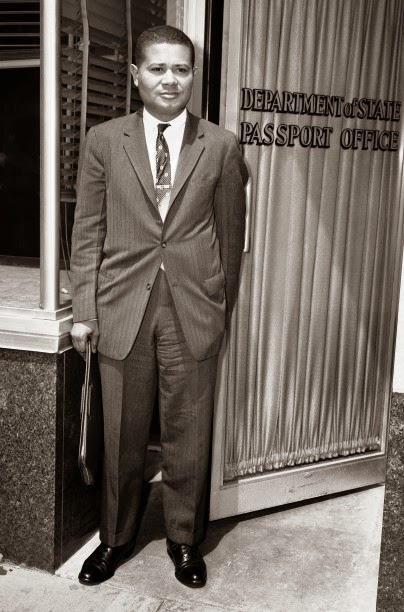



































 Columbian author Gabriel García Márquez has passed away. He was 87-years-old.
Columbian author Gabriel García Márquez has passed away. He was 87-years-old.















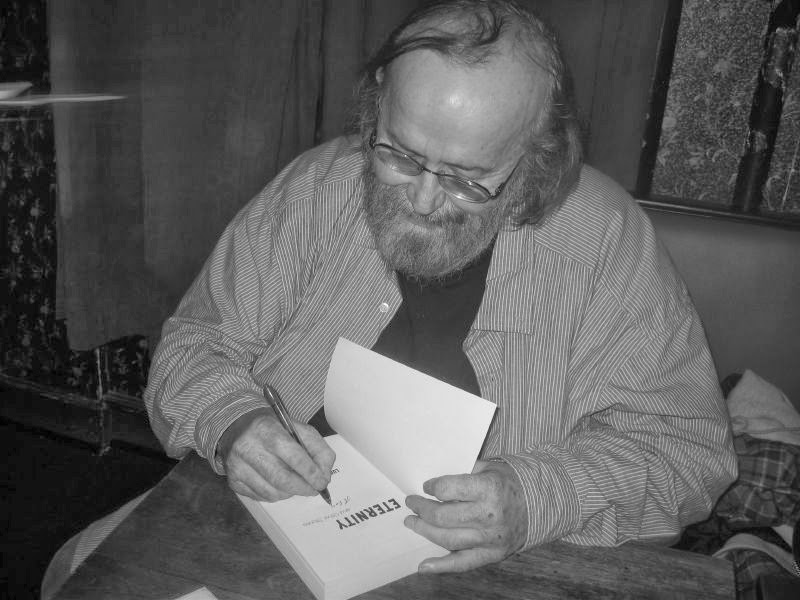



 Author Dr.
Author Dr.  Veteran comic book artist
Veteran comic book artist 
 Bestselling novelist Tom Clancy has passed away, ending a legendary career in espionage fiction.
Bestselling novelist Tom Clancy has passed away, ending a legendary career in espionage fiction.

 Hachette Book Group sales rep and bookseller Conan Gorenstein passed away this week. He was 64 years old.
Hachette Book Group sales rep and bookseller Conan Gorenstein passed away this week. He was 64 years old. Author E.L. Konigsburg
Author E.L. Konigsburg 
[…] Tweet […]
What a fascinating and enjoyablearticle: I’m looking forward to reading part 2 soon.
As an amateur photographer I’m flattered when people choose to use one of my photographs, but I think it would be polite to ask first and to give an acknowledgement of other people’s creative efforts.
https://flic.kr/p/egFVQY